CAMDEN, NEW JERSEY
![]()
Congregation
Beth El
Park
Boulevard &
Belleview
Avenue
![]()
Last UpdatedSaturday, January 10, 2015
![]()
|
Camden is well known for its ethnic communities. The large Polish, Italian, Irish, German, and Jewish communities played a great role in Camden's history in the 19th and first part of the 20th century, while Black and Puerto Rican families have given the city much of its recent flavor. There are other, lesser known ethnic groups that have made up the fabric of the city's life over the years. Greeks, Armenians, and Ukrainians grouped together in the city in Camden's growth years. More recently, Mexicans, Vietnamese, Jamaicans, Dominicans, Haitians, and Koreans have come to the city to live and seek the American dream. Congregation Beth El was Camden's first Conservative synagogue, representing one of American Judaism three main movements. The congregation built and occupied a wonderful synagogue and school building on Park Boulevard, opposite Farnham Park, after World War I, which it occupied until 1968, when the new building on Chapel Avenue in Cherry Hill was occupied. The Beth El buildings was used by the Parkside Catholic School in the early 1970s, and were renamed St. Bartholomew's Roman Catholic School within a few years. The buildings were torn down around 2000 to make way for the Boys and Girls Club building donated by Camden native Louis Katz, the owner of several professional sports franchises. In March of 2006 I received a package of information from Rabbi David Herman, the son of Cantor Louis Herman, whose voice for many years inspired the faithful at prayer, and Mrs. Yetta Herman, who was involved for many years in Jewish education at Beth El. Besides David's own story of people and events at Beth El and in Parkside, there were copies of the 80-plus pages of Beth El's history through 1970, which you will find on this page. This will obviously take a bit of time to scan into the website, but in time it will be presented here in its entirety. March 2006 |
![]()
|
IN THE BEGINNING "In the Beginning G-d created Beth El as a dream in the hearts of men". These words formed the opening sentence of Beth El's Golden Jubilee Proclamation read by President Martin Odlen at Kol Nidre services September 21, 1969 (5730). Who were the men who had the dream? Certainly Benjamin Natal, Camden's first Jewish lawyer, was not only one of the dreamers but also one of the great organizers and activators who helped turn the dream into reality. In the opinion of many, he might rightfully be called the "Founding Father" of the congregation. Before Mr. Natal's involvement in the Beth El dream, we can trace his communal activities back to 1912. Under his leadership, a group filed a certificate of incorporation in 1912 for the Young Men's Hebrew Association of Camden. "To promote and embrace the broadest cultural and social efforts and diversion, strongly emphasizing Jewish values, encouraging every ennobling aspiration, improving the intellectual and moral faculties, thereby bettering the Jewish community and maintaining it at its highest standard." The first meetings of the YMHA were on the second floor of Abe Furhman's furniture store at Broadway and Division Street. Soon after they moved to the Dannenhower Building at the Southwest corner of Broadway and Kaighn. On May 21, 1917 the YMHA chartered it's first real building at 572 Walnut Street. While in the Dannenhower Building, services were conducted on the High Holidays. These services were "modern" compared to the Orthodox services held in the existing synagogues. Later these services were held at the Towers Theater. After the YMHA was built on Walnut Street near Sixth Street, services were conducted in the "Y" Auditorium. A cantor was brought in from Philadelphia or New York. Amongst the leaders of these modern services were Harry Nurock, Israel Weitzman, Sig Schoenagle and Abe Fuhrman. It is not clear to what extent Ben Natal was part of the congregation at the YMHA but in 1915, he sent letters to the Jewish community of Camden with regard to forming, a "modern Orthodox synagogue" to be called Rodeph Sholom.
1920 On October 3, 1920, a meeting was held in Mr. Natal's law office for the purpose of organizing a new congregation in Camden. The twenty-five men present included Harry Barroway, Dr. Otto Reiter, Reuben Pinsky and Manny Pearl. Each of the latter four contributed fifteen dollars and the dream became real. According to Herman Natal in an interview published in the "Voice" September 1951, others at that meeting were Louis Cades, Kolman Goldstein, Harry Teitelman, Herman Natal, Louis Berkowitz, Morris Handle and A. I. Rovner. Jacob Leventon attended a subsequent meeting.
1921 The new location for Beth El at park boulevard and Belleview Avenue was secured in May of 1921 for the price of eight thousand dollars. Realizing that a large synagogue building would take quite some time to finance and build, the directors decided to first erect a School Building that would also serve as a temporary synagogue. Eventually, when the membership and funds would in-crease, a large synagogue building would then be built. Construction of the school building began in July of 1921 and was completed in time for the High Holy Days of that year, which began on October 3rd. By the time the building was completed, the congregation numbered close to fifty families. Before the High Holy Days of 1921, Beth El had elected an "English-speaking Rabbi". Rabbi Solomon Grayzel was a graduate of Columbia University and had just been ordained by the Jewish Theological Seminary of New York. The Cantor who officiated with Rabbi Grayzel at those first High Holiday services was Ephraim Fogelnest from New York.
On November 1, 1921, Beth El was officially incorporated by the state of New Jersey. On the Certificate of Incorporation, dated November 1, 1921, the founders were:
At the invitation of Rabbi Grayzel, the wives of members were invited to a meeting on November 1, 1921, for the purpose of organizing a Sisterhood. Mrs. Benjamin Natal (Minnie) became Sisterhood's first President. The School Building-Temporary Synagogue, was dedicated on November 13, 1921. It had been put up at a cost of $15,000. Taking part in the dedication service were Rabbi Mortimer J. Cohen of Philadelphia's Beth Sholom, Rabbi Max Klein and Judge John B. Kates of the Camden County Common Pleas Court. The Dedication Sermon was given by Rabbi Grayzel who was listed in the program as "minister of the congregation". The service also included a violin solo by Mr. Julius Cades. In the Dedication Service Book there were listed the names of the officers and directors of the congregation, the building committee, the officers of Sisterhood and the Beth EI Junior Auxiliary or Young People's Auxiliary whose president, Harry Berkowitz, was to become a future president of the congregation. It is interesting to note that on the invitation to the dedication of this, Beth El's first school building there was a note on the left-hand comer that read-"no children admitted". A Sunday School and a daily Hebrew School with "English-speaking teachers" were organized in the fall of 1921. Rabbi Grayzel also began teaching Beth El's first confirmation class. Morris Handle was reelected President of the Congregation.
1922 The first issue of the Synagogue's news bulletin was published on April 12, 1922. It was called the "Beth-Elite" and consisted of two pages. The bulletin appeared just before Passover and gave the holiday schedule of services. The front page reported a minstrel show having been put on at Beth El by the Camden Young Judeans under the direction of Mr. Harry Grossman. The paper had an optimistic, light note to it. Despite professing that the "leaflet" would print only "what is most important", the second page contained a rather juvenile joke and a recommendation to read a book called "Beggar's Gold" by Ernest Poole.
On the first day of the holiday of Shevuos, June 2, 1922, Beth El held its first confirmation service. The confirmation class consisted of seven young ladies, all approximately sixteen years of age:
That year Beth El engaged Cantor Jacob Mickleman. He had formerly been Cantor of Congregation Sons of Israel and he was to remain Beth El's Cantor until his retirement in 1941.
The forerunner of the "Beth El Ball" was a Chanukah Ball held in 1922 sponsored by Beth El in conjunction with the Council of Jewish Women. Until 1933, this annual affair was referred to as the Beth El-Council Ball. Commencing with the fourth annual Ball of 1925, an ad book journal was published. Chairmen of the Ball between the years 1925 and 1949 were some of Camden's leading Jewish per-sonalities: Philip Auerbach, Herman Odlen, Israel Katz, Meyer Sakin, Ben Natal, Albert Melnik, Norman Heine, E. George Aaron, Robert Brest, S. Mortimer Hirshorn, Louis L. Goldman and Irving Levinsky. These gala annual affairs were usually held either at Beth El or the Walt Whitman Hotel. Sometime after 1949, the Beth El Ball took on added meaning by highlighting the members of the Confirmation Class who were formally presented in a cotillion during the course of the evening. Succeeding Morris Handle as president was Louis Berkowitz. Mrs. Philip Auerbach (Rose) became the second President of Sisterhood.
1923-1924 Louis Berkowitz was reelected President of the Congregation. Mrs. Louis Paletz became Sisterhood's third president. By 1924, sixty children were enrolled in the daily religious school. An additional one hundred and fifty attended the Sunday School. A building fund drive for a main synagogue building was initiated. On the twenty-second of June, the cornerstone of the new synagogue was laid. At the cornerstone laying ceremony guest speakers included Rabbi Max Arzt of Scranton, Pa. and Dr. Julius H. Greenstone.
Beth El's new synagogue building was to cost $75,000. It was to be a two-story building, 60 x 60 feet. The new synagogue was completed in time for the high holidays of 1924. Camden's newspapers described it as the prettiest and largest synagogue in South Jersey. The building contained 500 seats in the main sanctuary plus 100 more seats in the balcony. Dedication of the new synagogue took place on December 14, 1924. Participating in the ceremonies were Mayor Victor King of Camden, Dr. A. A. Neuman of Philadelphia's Adath Jeshurun, Judge William M. Lewis of Philadelphia and Rabbi Samuel Freedman of Beth EI in Philadelphia. Rabbi Grayzel and Cantor Mickleman officiated at the service. The Cantor was accompanied by a choir under the direction of Gedalia Rabinowitz. By the fall of 1924, Beth El's membership numbered more than two hundred families. The Rabbi's salary was $4,624. The Cantor received the annual wage of $1500. The janitor's salary was $900. By 1926 the Cantor still received $1500 but the janitor had been increased to $1128. Beth El's telephone bill for the year 1923-24 was $48.14. In 1924 Louis Berkowitz and Mrs. Paletz were reelected to their respective offices in the congregation and sisterhood. Isadore "Pete" Herman became president of the Junior-Young People's Auxiliary.
1925 The pattern for Beth Ers eventual dues structure was proposed in the "Beth Elite" of May, 1925. An article mentioned "how dreadful it was for the Rabbi to have had to make an appeal for funds on Rosh Hashonoh", A plan was described whereby a "lump-sum" payment would include membership dues and two seats for the High Holidays as well as tuition. Whether this plan was adopted at that time is not known. The Beth El Ball Ad Book of 1925 brought in "much needed revenue", These yearly journals also provide us with some record of the congregation's activities and carry the tenor of the times as well. In the 1925 ad book there appeared a half page ad from a fuel oil burner company with the message, "Whose hands will shovel your coal next winter?" In the 1926 book, an ad read, "Park your car at the Ferries, Penna, and Reading," Benjamin Natal succeeded Louis Berkowitz as president of the congregation. Mrs. Louis Paletz was reelected as sisterhood's president.
Members of the Confirmation Class of 1925 were:
1926 Rabbi Grayzel was apparently disillusioned with the "profit-motive" as the impetus for the Beth El Ball and Journal. In his message for the Journal of 1926, he wrote, "It is a result of the deplorable fact that our synagogues are poorly supported … shall we not look forward to the time when such gatherings will be called out of motives not of profit, but of a pure desire for joy and festivity." After seeing Beth El through its incubator period from the Fall of 1921 until June of 1926, Rabbi Solomon Grayzel left Beth El and the rabbinate. During those five very crucial years, Rabbi Grayzel endeared himself forever to Beth El and the entire community. His inspiring leadership molded the character of the synagogue and greatly influenced its future course as a leading conservative synagogue and great community influence. Upon leaving Beth El, Rabbi Grayzel went to Europe to continue his studies. He later received his Doctor of Philosophy degree from Philadelphia's Dropsie College. From 1929 to 1940, he taught history at Gratz College. In 1933, he published a book called, "The Church and The Jews in the Thirteenth Century". In 1962 he became secretary of the American-Jewish Historical Society. He was to become one of the great Jewish historians of our times, attaining the post of editor of the Jewish Publication Society in 1939. He published his classic "History of the Jews" in 1947. It has become a universally acclaimed text book. He continues to serve on the faculty of Dropsie University. Although Rabbi Grayzel left Beth El in 1926, he was to come back from time to time to take part in official occasions and to lend his presence to every important milestone in the congregation's path forward, a path which he so lovingly and expertly pioneered. In an in-terview published in the Exponent (1959), he said, "It was Beth El in Camden that really made a mentsch out of me. I had to wear a moustache so that they could distinguish me from the children. Imagine the shyest person in the world. I was it. But they treated me like an oracle. They agreed with me. They listened. They gave me confidence. Can you imagine what that meant to a withdrawn religious intellectual like me? I was eternally grateful" . Rabbi Grayzel was tendered a farewell dinner on October 3, 1926.
Dr. Cyrus Adler, President of the Jewish Theological Seminary was guest speaker. By then Beth El's new rabbi was Arthur H. Neulander who served the congregation for one year. Ben Natal was reelected to a second term as president of the congregation. Mrs. Herman Odlen (Clara) became Sisterhood's fourth president. Sometime in 1926, the first woman ever to speak from Beth El's pulput was a young Zionist named Goldie Myerson. She had come to Camden to speak about "Palestine". It would be interesting to know if Israel's Prime Minister, Golda Meier, recalls her experience at Beth El in 1926. 1927 Rabbi Neulander left Beth El in 1927. He recently retired as Rabbi of the Jewish Center of Bayswater in New York. He is one of the Conservative Rabbinate's leading authorities on Jewish law. He was succeeded at Beth El by Rabbi Nachman S. Arnoff. Rabbi Arnoff, Beth El's "bachelor Rabbi", was also a graduate of the Jewish Theological Seminary. He had spent eight months living and studying in Jerusalem before coming to Camden.
Mr. Louis Cades became Beth El's fourth president, and Mrs. Mark Obus (Anna) became president of Sisterhood.
1928 In 1928 the Synagogue's bulletin, The Beth-Elite acquired its current title, The Beth El News. A new publication appeared on the Jewish scene in Camden called "The Community Observer." The first issue appeared in May of 1928. Rabbi Arnoff was listed as Editor; Ben Cohen-Co Editor, Reba Obus and Lillian Grass-News Editors; Carl Auerbach-Business Manager, and Leon Mickleman-Circulation Manager.
There is evidence pointing to High Holiday services for children being held in the Beth Hamedresh-Chapel of Beth El. The Community Observer contained an item in its first issue telling that young Bobby Galanter had a perfect prayer in Hebrew School for the month of April. Despite the pending national economic crisis Beth El's members contributed generously towards their synagogue. At a Board of Directors meeting, when it was revealed that the Synagogue was in the throes of a financial crisis due to a nine thousand dollar deficit, within a matter of minutes seven thousand dollars was raised amongst the Board MeIJ1bers. In November of 1928, Rabbi Arnoff gave a sermon at a Friday Night Service called, "Can Peace Be Maintained With a Big Stick- a criticism of President Coolidge's Armistice Address." The members of the Mizpah Lodge were scheduled to attend the service "as a body". Mizpah Lodge to this day includes many of Beth El's outstanding members. In November of that year Jacob Leventon became President of the Congregation. The installation was accompanied by a banquet at which Dr. Grayzel and a Doctor Benjamin H. Bernbaum, Rabbi of Boston's Adath Jeshurun Synagogue were the guest speakers. Mrs. Obus continued on as Sisterhood President.
1929 Because of economic conditions, the Beth El News was mimeographed instead of printed. The practice of reading the names of the "Yahrzeits" at Friday night service began in 1929. In the Beth El News of May 1929, there is a note about plans for a summer school in which Hebrew would be taught three times a week in addition to a recreational program in nearby parks. In the Community Observer of November 1, 1929, there is mention of a High School Department being started at Beth El, "mainly for the boys and girls who have been confirmed at Beth El". Jacob Leventon was reelected to the presidency of the Congregation, as Mrs. Obus continued to serve as Sisterhood president. Congregation Beth Israel was organized in East Camden. The Twenties come to an End Sisterhood's early activities already showed great evidence of the dominant role they would play in Beth El's history. Fund raising, gifts to the children at holiday times, putting on plays, equipping the kitchen, decorating the Sukkah and the synagogue, serving "a tea" following the Friday night service, presenting scholarships to the religious school, supporting the Jewish Theological Seminary (Sisterhood joined the Women's League of the United Synagogue at their third meeting in 1921) were but some of their activities in that first decade. Sisterhood's first annual indoor Bazaar started in 1929 and was to continue for many years. It was in Beth El's first decade that organizations and activities of great variety began. Boy Scout Troop 18 was organized- the Shalesh Sudos- the Beth El Book Club- a Junior Hadassah. The synagogue became the center of every important Jewish activity and fund-raising project. The Hebrew Free Loan Society, a Federation drive, a Zionist Organization, a Hebrew Ladies Charity which was in charge of needy cases and lodging and board for the stranger, Council of Jewish Women, a Junior League, B'Nai Brith, AZA. All these were interwoven with Beth El and drew their leadership from South Jersey's most rapidly growing synagogue. The decade ended on a sad note for World Jewry when the horror of the Arab pogroms in Palestine became known. Under the chairmanship of one of Beth El's most esteemed leaders, Attorney Leon H. Rose, an emergency committee raised four thousand dollars to send to Palestine. Again Mr. Leventon and Mrs. Obus were chosen to retain their presidential offices as the decade of the thirties began. The members of the Confirmation Class of 1929 were:
1930 Stephen S. Wise visited Camden and delivered a "stirring eulogy" of American's wartime president, Woodrow Wilson … The Community Observer mentioned a reorganization of Camden's Federation of Jewish Charities, Beth Elite, Abraham Furman was elected president … Sisterhood's Bazaar raised over $1,000 in two nights Tillie Evantash and Abraham Cutler had parts in the Beth EI School's Chanukah program … Meyer Sakin was chairman of the Beth El Ball … Sisterhood began sponsoring a Saturday afternoon Story Hour for the children. Jacob Leventon was re-elected to a third term as president of Beth El. Mrs. I.S. Siris (Anne) became Sisterhood president. Members of the Confirmation class of 1930 were:
1931 Although Beth El had been organized in 1920, the tenth an-niversary was celebrated by Sisterhood at a special meeting on December 7,1931. The meeting was held in conjunction with Hadassah and Council of Jewish Women. Guest speaker was Dr. Israel H. Leventhal of New York's Brooklyn Jewish Center. He was the son of Philadelphia's "Chief Rabbi", Bernard Leventhal, one of American Jewry's renown Orthodox leaders. The "tenth" anniversary was also commemorated at the Friday night services on December 11. Rabbi Grayzel was the guest speaker. The anniversary festivities were climaxed at a banquet on December 13. Mr. Leventon and Mrs. Siris were re-elected to office. The Confirmation Class of 1931 consisted of:
1932
1933 Despite economic conditions, Kol Nidre appeals were still conducted. Contributions of three dollars were greatly appreciated. There existed in Camden at that time, a Jewish Welfare Society that set a $3,500 goal in 1933. Ben Natal, writing in the Beth El Ball Journal that year, said "in these days of depression an evening spent in merriment and diversion will relieve us of that morbid feeling and bring back hope for a bright future." In October of that year, five adult education courses were offered. A Forum Series was presented featuring Maurice Samuel, Professor Mordecai Kaplan, Reverend John Haynes Holmes, and Professor Harry Overstreet. The Forum was officially called "The Program Committee." It was a joint effort with Hadassah and Council of Jewish Women. Rabbi Arnoff also gave a series of Sunday morning lectures. Joseph S. Kaplan became President of. the Beth El League. Mr. barroway and Mrs. Abramson continued as Presidents of Congregation and Sisterhood. Norman Heine again became President of the Council of Jewish Juniors.
1934 December 16th, 1934 marked the annual dinner and installation of officers. At the affair the program featured the Beth EI Choir consisting of Mrs. Maurice Russell (Sadie), Joseph Becker, Samuel Gordon, and Harry Silver under the direction of Cantor Mickleman. We also find reference to a Zionist youth group called "Gordoniah" led by their President, Ben Zion Steinberg. Israel Katz became Beth El's new President. Mrs. Morris (Esther Quint) Rabkin was elected Sisterhood President. Morris Albert succeeded Norman Heine as Council of Jewish Juniors President.
1935 Sometime before the Spring of 1935 Rabbi Amoff left Beth El. His future was unfortunately short lived. He became a Chaplain in the United States Army during World War II and was killed in an army truck accident following his discharge at Fort Kilmer. A memorial service was held for him at Beth El on September 22, 1946. Beth El's search for a new rabbi ended when Rabbi Philip Lipis spoke at the synagogue on Friday night, March 22, 1935. He was officially elected to the pulpit in April. In his letter of acceptance, he wrote, "I pray that my election as rabbi of Beth El in this Passover season of freedom may bring to Beth EI freedom from inertia and a rebirth of activity and service, Jewish and human."
Rabbi Lipis had been ordained at the Jewish Theological Seminary in 1930 and had been rabbi of Emmanuel Congregation in Oak Lane, Philadelphia. During his first five years at Beth El he was to greatly revitalize the Forum Series, organize a Men's Club, the Alumni, the Tephillin Club, a Junior Congregation, the Special Fund, a Hebrew High School Class (1938), and the Institute of Jewish Studies. Jesse Satenstein became president of the congregation. Mrs. Ben Natal (Minnie) again took Sisterhood's highest office. Carl Auerbach became president of the Council of Jewish Juniors.
The Confirmation class of 1935 included:
1936 The Beth El Journal contained a special tribute to the memory of Philip Auerbach, "sincere, earnest, indefatigable"" chairman of the Beth El Ball Committee since its inception. Mr. Jesse Satenstein and Mrs. Ben Natal were re-elected to head the congregation and sisterhood.
1937 In the Beth El Ball Journal of 1937, Rabbi Lipis wrote about, "the new spirit- a spiritual rejuvenation at Beth El". He wrote of the successful Forum, organization of an alumni and the beginning of the Men's Club which he had organized in January of that year. Samuel F. Ginns became the Congregation's eighth president. Mrs. Harry Lutz (Zelda) became Sisterhood president.
1938 Leon Rose was general chairman of the Beth El "Public Forum". Featured in the 1938-39 series were Milton Steinberg, Pierre Van Passen, Horace Kallen, Gerald P. Nye and Dorothy Fuldheim. Each program had a different chairman. The price for the entire series was $1.50.
Samuel Ginns continued on as congregation president. Mrs. William (Reba) Laub became sisterhood president.
1939 In a "poem" printed in the Beth El Ball Journal, February 1939, Chairman Milton C. Nurock wrote about Rabbi Lipis as follows: "Our association with Rabbi Lipis found him ever ready to slip us a good suggestion or two, on how to make this evening nice and pleasant for you." Another article in the Journal mentioned the possibility of building a Community Center. The writer suggested putting up an annex at Beth El instead of "a separate monumental structure which would require a tremendous initial outlay and a high cost of maintenance and would not have a permanent existence in this city." In the Beth El News we find an article urging the Congregation members to vote "No" to legal race track gambling for New Jersey. "The welfare of our community calls for an emphatic No!" One can only surmise what the future development of today's Cherry Hill might have been, or not have been, had the race track amendment to the Constitution of New Jersey been defeated at that time. By 1939 the name of E. George Aaron had achieved great prominence in Camden. His towering figure and exciting personality made him beloved and respected by Jews and non-Jews alike. A biography of him in the "Voice" described his "quick wit, vivid phrasing and brilliance." Mr. Aaron became president of Beth El in 1939 and was to playa dynamic role in the synagogue and Jewish community at large. Kol Nidre night of 1939 was an historic evening in Beth El's development. A rousing appeal for funds was made by Commissioner Aaron, Meyer Adleman and Rabbi Lipis. The result was the payment of the synagogue's mortgage after some negotiation. In the Fall of 1939 the adult education courses became a cooperative venture of Beth El, B'nai Brith, Sisterhood, Hadassah, Council of Jewish Women and the Council of Jewish Juniors. The faculty included Dr. Philip Birn-baum, principal of the Camden Talmud Torah since 1938, Dr. Mortimer Cohen and Rabbi Lipis. The program was called Beth El's adult "pop" courses. Leon H. Rose was again chairman of the Forum series. Zelda Lutz was re-elected sisterhood president.
SISTERHOOD IN THE 1930's Besides working for the Synagogue, Sisterhood provided help for the Red Cross Flood Relief, the Falasha Committee, the Braille Institute, the No Foreign War Crusade. By the Fall of 1935 Sisterhood had two hundred members, annual dues were $2.00. That year Sisterhood sponsored a Simchas Torah Party for adults. Price of admission was one cent for every inch of one's waistline. Sisterhood had representatives on the School Board. They sponsored a current events group, visited hospitals, gave "a donor luncheon and bridge," and were very much involved in the Tephillin Club. On Armistice Day, 1935, Sisterhood sponsored a "Peace Meeting" attended by three hundred people. Their activities also included participation in Deborah, Federation, and the Jewish Theological Seminary. Sisterhood organized the Children's Seder, gave prizes to Hebrew School children at graduation and put on a Saturday afternoon story hour for the youngsters. A quaint project by Sisterhood in November of 1934 was the selling of "Sundry Household Goods" to meet their donor luncheon pledges. Items for sale were homemade bread, unsweetened chocolate, flavotint, playing cards, and chances on a hand knit blouse. As early as the 1930's the children of the Hebrew School were conducting Sisterhood candy sales. The Confirmation Class of 1939 included:
In the first half of this decade, Rabbi Arnoff had preached many a sermon on the growing anti-Semitism in Communist Russia and Germany. Rabbi Lipis continued to speak on these fearful themes as Beth El entered the decade of the forties the threatening clouds of Nazi Germany had already erupted. 1940 At the start of Beth El's third decade, the war in Europe was beginning to turn into a conflagration. The terrible tenor of the times was being felt by Camden and throughout America. The Beth El Ball Journal of 1940 was entitled "The American Way- Life, Liberty and The Pursuit of Happiness." On the cover were pictures of Lincoln and Washington. The Journal contained President Roosevelt's picture and patriotic messages from Rabbi Lipis and others. The menu contained a note that ration cards would not be honored. This Journal also gave sad tribute to the memory of Leon H. Rose, one of Camden Jewry's most able and distinguished leaders who had passed away at an untimely age. That year Rabbi Lipis delivered the main address at the dedication of a new suburban synagogue, Temple Beth Sholom of Haddon Heights. The Jewish Theological Seminary held a conference at Beth El in March. Amongst the speakers was a young Rabbi from Beth Israel of Vineland, New Jersey named Harry B. Kellman. The impression he made must have been quite lasting since seven years later he was to replace Rabbi Lipis. In May of 1940, on the recommendation of a nominating committee headed by Morris Liebman, the membership approved the establishment of an honorary Board of Directors to be composed of all former Presidents. The Board consisted of Commissioner E. George Aaron, H. L. Barroway, Louis Berkowitz, Samuel F. Ginns, Morris Handle, Ben Natal and Jesse Satenstein. On June 2, Meyer Adleman was installed as Beth El's eleventh president. Mrs. Samuel L. Rosenberg (Sara) succeeded Zelda Lutz as president of sisterhood.
On the High Holidays, the Council of Jewish Juniors conducted services for the young men and women of the community in the synagogue's chapel for the second year. A rabbinical student of the Seminary was engaged to officiate. Rabbi Lipis was scheduled to speak on one day of Rosh Hashona to the "Congregation of Young People". On November third of 1940, Beth EI reached a historic milestone by observing a triple celebration. A gala Banquet marked (1) "the payment of the mortgage debt on the synagogue building." (2) the fifth anniversary of Rabbi Lipis' tenure at Beth El. (3) the twentieth anniversary of the founding of the congregation. The evening included the "burning of the mortgage document." Ben Natal was chairman of the festivities. Rabbi Samuel Fredman of Philadelphia's Beth El, Rabbi Simon Greenberg of Har Zion, Rabbi Mortimer Cohen, Dr. Grayzel and Rabbi Lipis were present. Participating in the mortgage-burning ceremony were the Honorable E. George Aaron, Chairman of the Mortgage Reduction Fund, Joseph Galanter, treasurer of the congregation and President Meyer Adleman who had recently been feted at a testimonial dinner for his support of religious education and Palestine. Mr. Adelman was to establish one of the noblest records of generosity in the history of this community or any other Jewish community. Every worthwhile fund raising endeavor was to have the names of Meyer and Fannie Adleman at the very top of the list of contnbutors. On the Friday night preceding the banquet, services marked the twentieth anniversary of sisterhood. Dr. Max Arzt of the Jewish Theological Seminary of New York was the guest speaker. A special address was given by Mrs. Milton (Natalie) Gordon on the Sanctity and Beauty of the Sabbath. She was in later years to become one of the Jewish community's leading personalities. The program con-cluded with "mass singing". Sisterhood, for a change of pace, held a horse show at the Dog Track, Central Airport, sponsored by the Bit and Bridle Club of Woodbury. On the back of the news item in the Evening Courier telling of Sisterhood's twentieth anniversary celebration, there appeared a front-page article on Camden's first draftee. "Cheers greet first number in the city. Others are delighted they may join the war". 1941 President Meyer Adleman told a special committee entrusted with the task of raising $3,000 in Journal ads for the Beth El Ball of 1941, that if they succeeded, every member on the committee would be his guest in a night of "royal celebration." Whereupon Manny Pearl added he would contribute in cash twice the amount of the cost of the party. The Honorary President, Jacob Leventon, then declared he would match Mr. Pearl's gift. The time seemed ill fit for festivities. In his Journal article, Mr. Adleman quoted a modern writer who said "the lights of civilization are slowly going out." Rabbi Lipis wrote, "People are saying this is no time for merrymaking. With the world drenched in blood, bathed in sorrow and groaning under its travail, what is there to be happy about? … We (at Beth El) have created tonight's atmosphere to prove that trials and difficulties have not unbalanced us." In May of 1941 a group of "young marrieds" was organized at Beth El called the "Associated Membership." Leon Weinstein was acting chairman, Mrs. Edward Natal (Reba), acting secretary. Sisterhood raffled a two-door "Chevy Coach" whose list price was $838.00. Price of the raffle ticket was twenty-five cents. The forum that year presented Max Lerner before an enthusiastic audience. Morris Liebman succeeded Meyer Adleman as President of the Congregation. Mrs. Aaron Heine (Miriam) followed Mrs. S. L. Rosenberg as president of Sisterhood.
In September of 1941, the first issue of "The Voice" was published by the Camden County Jewish Federation. The front page showed a picture of Beth Elite, E. George Aaron, Commissioner of Public Safety together with an article telling of his being named chairman of the Camden United Jewish Campaign whose goal was $47,257. Almost all the other officers of the campaign were Beth Elites as well. Isadore, "Pete" Hermann was president of Federation. In a lengthy article in the Voice, Rabbi Lipis, who together with Albert Klein, was given credit for organizing Camden's "Anglo-Jewish newspaper", wrote of the Warsaw ghetto's 450,000 Jews, the victories of Nazi Germany in the Balkans, the ever growing threat to Jewish survival in Europe, the Nazi invasion of Russia in June, and the British policy in Palestine. The Voice contained High Holiday messages from Beth Israel's new Rabbi, F. D. Plotke, Rabbi Riff and Rabbi George Vida of Beth Sholom. Congregation Ahav Zedek, though without an "all-year rabbi", was preparing to engage a Rabbi for the holidays. There were references to the Camden Talmud Torah and the Workmen's Circle School. Cantor Jacob Mickleman after twenty years of devoted service resigned due to ill heath. The congregation bestowed upon him the title of "Cantor Emeritus" as Cantor Zelig Lipp took over his cantorial duties. At Sisterhood's opening luncheon in November of 1941, vocal selections were rendered by a "Miss Geraldine Guerra of Oaklyn, accompanied by her sister, Selma." For young Geraldine this was the beginning of a lifetime of service to Beth El. Bea Slutsky (the future Mrs. Robert Kaplan) became president of the Council of Jewish Juniors. 1942 America had entered the war following the Japanese bombing of Pearl Harbor on December 7 of 1941. During the war years, Beth El went all out for the "war effort." Patriotic slogans appeared in the Beth El News and Journals. "Support the Mighty Seventh War Loan". "A B29 Superfortress used in the bombing of Japan costs $600,000. Buy an extra $100 bond." The News listed names and addresses of servicemen in far-flung places as well as the names of "the boys" home on furlough. Services were constantly saturated with prayers for peace and victory. In February of 1942, Leon Weinstein was president of the Associated Membership (also referred to as the Associated Congregation) which was the forerunner of the Young Associates of the 1960's. In later years, Leon was to become Beth El's foremost comical actor in the synagogue's theatrical productions. Martin Odlen, a future president of the congregation, was chairman of the Ways and Means Committee of the new organization. The Beth El Ball in March was referred to as the Pan-American Frolics Ball. Price of admission was $3.50 which included free rhumba lessons. This was in Rabbi Lipis' words, "Beth El's first social function since war was thrust upon the peace-loving American people".
Also in March, plans for a Jewish Community Center were being formulated by an association chaired by A. David Epstein, then a young lawyer in his thirties. It was quite evident that nothing could really be done along those lines until after the War. E. George Aaron headed the Allied Jewish Appeal Drive; Florence Melnik was in charge of the Women's Division … In April of that year the "Hebrew Congregation of Merchantville (Beth Jacob) dedicated its new synagogue … In May, the Federation announced sponsorship of a summer day camp, the forerunner of Camp Hilltop. Beth El's Rabbi and lay leaders, blessed with foresight, realized that a new school building would eventually be needed. In June of 1942, a group of men jointly bought a lot adjoining the synagogue on Park Boulevard. The men were: Meyer Adleman, Louis Berkowitz, Leon Cooperson, Henry Cooperson, Isadore Blume, Herman Cornfeld, Herman Z. Cutler, Joseph Galanter, Jesse Satenstein, Morris Handle, Max Holzman, Harry Grossman, Jacob Leventon, Sol Rosenberg, Sam Marochnick, Manny Pearl, Walter Saline, Meyer Sakin, Leo Spector and Hy Myers. That same year a young man by the name of Herbert Kolosky joined the Sunday School staff. Twenty-Five years later he was to become Associate Architect for the new Beth El of Cherry Hill and twenty-eight years later he became vice-president of the congregation. He was also to become one of the leading figures in the Bureau of Jewish Education and National President of Bn'th Shalom. By November, the new president of the Associated Membership was Harold Heine. On November 15, the Associated Membership sponsored the dedication of the Flag Pole and unfurling of the Service Flag ceremonies. Chairman of the project was Edward Natal, son of the congregation's first secretary, Herman Natal. Ben Asbell provided the synagogue with its first Hertz Bibles (chumashim) for use at Sabbath services. At High Holiday services the Silverman Machzor was in-troduced. The Kol Nidre fund-raising public appeal was eliminated for the first time. The United Thanksgiving Service sponsored by all the local synagogues was inaugurated and still continues as an annual event in our community. In December, the Forum featured Professor Mordecai M. Kaplan. Earlier that year Molly Picon was the Forum star. The Forum also featured Professor Sidney Hook. During Dr. Hook's lecture, a war "blackout" was scheduled but did not interfere with the program since Sisterhood had prepared the required blackout curtains. Morris Liebman was re-elected president of the congregation. Mrs. Victor Levenson (Rhenette) became president of Sisterhood. In
the Fall of 1942 Beth El offered a free Sunday School for the children,
a
nursery school for children ages 3-5, a tephillin dub for boys 12-14
that met
Sundays at 8 (until this day), an associated membership for young
married
couples and young single people and, according to an article in the
"Voice" of September, 1942, "free burial plots in the
congregation's cemetery like other modern synagogues! "
1943 The Beth El Ball of February 1943 was entitled the "Freedom Jubilee." The Second World War was then at its height and the Ball was dedicated to the "members of our community who are serving in the armed forces of our country." The last page of the Journal was a gold page with a list of names of Beth El's servicemen. Next to Rabbi Lipis' picture was a note informing the congregation that he was soon to leave Beth El having enlisted as a Chaplain in the United States Navy. Rabbi Lipis was to be away in the service of his country for three years. In his message, Rabbi Lipis appealed to the membership to "Keep the synagogue, its allied organizations, the school and services and its varied activities strong and growing". Sisterhood's president, Rhennette Levinson, described in her message the efforts of her organization for Red Cross, U.S.O., etc. Throughout the Journal, there appeared pleas to buy war bonds and stamps. Amongst the ads was a box that read as follows, "this space reserved for a death notice-names are to be listed as follows: Hitler, Hirohito, Mussolini". Editor of the 1943 Freedom Jubilee Beth El Ball Journal was Philip Zinman, destined to become one of America's great Jewish philanthropists and U.J.A. leaders.
In March of 1943, Rabbi Max Weine, who had been Rabbi in Rutland. Vermont, began his service as Beth El's interim Rabbi while Rabbi Lipis was a Navy chaplain. The late Friday night services were conducted in the auditorium instead of the main sanctuary in order to conserve oil. Memorial tablet sales were stopped because of the shortage of bronze, but Beth El's basic religious, cultural educational and social programs continued. Around Purim time Sisterhood put on a minstrel show directed by Simon Weiss. The show featured a whistling solo of "Embraceable You" by Mildred Nurock. The show highlighted a duet by David Rosenblatt and a young singer named Geraldine Guerra in "If Love Were All." Miss Guerra also sang a solo selection and became "the voice" of the Beth El Choir. She was to become Mrs. Joseph Ostrov, the future sisterhood president, teacher in the religious ,school, leader of the Junior c ongregation and remains one of the sparkling personalities of synagogue and communal life. The Beth El Forum of 1943-44 featured James McDonald, Dr. Will Durant and Erika Mann-daughter of Thomas Mann. Ben Zion Steinberg, Beth El teacher and Labor Zionist leader, wrote a regular column in The Voice called "On the Jewish Scene". The Voice printed letters from some of Beth El's servicemen. Captain Harry Fridrich wrote, "We have a large P. X. which has almost everything that the Bell Drug has. I'll have to brush up on my French. Oooh lala." A few issues later, Captain Fridrich wrote from Africa, "I have become engaged; at last, I have done it, … the most lovely girl in the world, … none other than Florence Kravitz of Collingswood." In November, Chaplain Lipis wrote, "Never in the thirteen years of my rabbinate have I had such a continuous, daily, sustained sense of satisfaction in my work as these days". Beth El's members played an important role in the Allied Jewish Appeal. Isadore Borstein became chairman for 1943-44. Serving with him were Maurice Clyman, Lester Abrahamer, George Aaron, Harry Antelmen, Samuel Goldberg and A. David Epstein. The Second Annual United Thanksgiving services were held at Beth El. Chaplain Lipis took part, together with Rabbi Weine and Beth Israel's new Rabbi, Mordecai Poupko. Morris Liebman continued as Beth El's president. Mrs. Louis H. Sherman (Diana) became president of sisterhood.
1944 The twenty-third Beth El Ball on March 26, 1944, at the Walt Whitman Hotel in Camden was dedicated "to our fighting allies". President Morris Liebman expressed a hope and a prayer via his message in the Journal, "that the combined forces and resources of our allies will bring to a speedy close the Second World War. At home we at Beth El are continuously doing our share to help the cause of our fighting allies by maintaining and preserving our religious institutions and our community life and spirit … we are concluding a very successful year in that its finances are in a favorable condition and its social activities have never been better attended … another activity which is closely associated with the synagogue is Zionism … meetings at Beth El were held in protest against the British White Paper so that Jewish immigration to Palestine will not be restricted. We hope that our prayers will be answered with the abrogation of the White Paper and … bring about a Jewish National Homeland in Palestine."
A message appeared in the Beth El Ball Journal from Rabbi Max Weine who in Rabbi Lipis' absence was serving as Beth El's "acting rabbi." Rabbi Weine wrote of the day when "our boys come home and will have realized the profound truths of religion … and experience a burning desire to be closer to Jewish life … We of the Home Front who, are far from the horror of war should prepare and improve Beth El for the homecoming" . There was also a message from Chaplain Lipis together with a picture of him in Navy uniform. In his message he praised Rabbi Max Weine for his "inspiration and guidance."
On June 18th, Morris Liebman was installed for a fourth term as President of the congregation. Mrs. Max Pincus became Sisterhood President. At the installation, chaired by Commissioner Aaron, both Rabbi Weine and Chaplain Lipis spoke. In November of 1944, under the chairmanship of Ben Natal, a drive was started for the purpose of putting up an Honor Roll Tablet listing those serving in the Armed Forces. Members of the Confirmation Class of 1944 were Helen Buck, Andrea Heine, Leon Kutner, Janice Levy, Theodore Tarter, Mildred Russell, Serita Ruttenberg. 1945 In 1945 Beth El's dues were $25.00 but some members voluntarily increased their dues to $50.00. The congregation numbered approximately 350 members. On May 13, 1945, the Servicemen's Tablet was dedicated. Rabbi Weine officiated at the dedication. The Honorable E. George Aaron, Director of Public Affairs of Camden was on the program together with Mayor George Brunner. Among those listed on the tablet were two names that followed each other in alphabetical order, Ensign Martin Odlen and Staff Sergeant Joseph Ostrov. Twenty-five years later, they were to follow each other as presidents of Beth El.
The Bureau of Jewish Education was organized by the Federation in 1945. Norman Heine became the first chairman. The Bureau served the Camden Talmud Torah, Beth El, Beth Israel, Beth Sholom, Beth Jacob and the Workmen's Circle school. In June, Beth El's A. David Epstein became president of the Federation.
The Hebrew School's annual Lag B'Omer outing at Camden High School's athletic field on May 6th was called the Maccabiad and featured the following prize-winning athletes: Barry Brown, Mitch Rabkin and Bobby Savadov. In the Beth El News of May, President Liebman's report mentioned that a chairman had already been appointed for the project of putting up a new school building on the land adjoining the synagogue. Beth El's budget in 1945 was $17,000. Meyer Sakin succeeded Morris Liebman as congregation president. Mrs. Pincus remained as sisterhood president.
Members of the 1945 Confirmation Class were:
1946 In January, Harry Berkowitz was appointed to the American Prosecutor's staff of the German War Criminal Trials at Nuremberg. He wrote a letter to the "Voice" from Dachau, Germany, where he had successfully prosecuted ninety-one Nazis who were then sent to the gallows … A. David Epstein was President of Federation in that crucial post-war year … S. Arthur Levy, another of Beth El's staunchest leaders was President of Camden's Zionist Organization … In November of that year the news was circulated of the formation of Camden's first Jewish country club, called Crest Hollow, forerunner of the Woodcrest Country Club. They held their first meeting at Beth El on December 12. Joe Galanter, former Beth El treasurer, became the first President of the country club … Ed Segal became President of Council of Jewish Juniors … Beth El's Forum presented Drew Pearson at Camden High School … The new Siddur, edited and published by the Rabbinical Assembly, was introduced at Beth El. Beth El's 25th Anniversary- the Silver Jubilee- was celebrated with a dinner dance at the Walt Whitman Hotel on April 13, 1946. In that first post-war journal, as in the other Beth El Journals of that period, there appeared the names of men who had been part of Beth El's history since its inception. Those who were to achieve prominence in years to come at Beth El and in the Jewish community were: Epstein, Tucker, Schatz, Asbell, Goodman, Handle, Blume, Kahlowsky, Milask, Lichtenstein, Satenstein, Leventon, Bloom, Goldstein, Schiff, Ginns, Cades, Spector, Clyman, Schomer, Sussman, Obus, Ruttenberg, Rosenfeld, Brandt, Liebman, Odlen, Saline, Pearl, Schwartz, Rosen, Zubrin, Kaplan, Gordon, Aaron, Naden, Borstein, Heine, Hishorn, Levy, Lutz, Melnik, Nurock, Sherman, Siris, Sklar, Galanter, Teitelmen, Yubas, Cooperson, Albert, Levinsky, Cutler, Pinsky, Markowitz, Brodsky, Natal, Berkowitz, Adleman, Barroway, Bass, Fridrich, Rappaport, Rosner, Russell, Schreibstein, Tapper, Greenberg, Brown, Dzick, Kutner, Left, Myers, Goldman, Auerbach, Brest, Hermann, Lebow and Zinman. The Beth El News previewed the event by announcing that "the iron curtain will fall on reservations once the number of 250 was reached. Several tables will hold veterans as guests". The evening was later referred to as "the most successful social affair in Beth El's history. A Mr. Joseph Cooper presented as a personal gift to each woman present a pair of nylon stockings. The applause and laughter were deafening". The commemorative journal contained Rabbi Lipis' picture and mentioned that this was his first Beth El Ball since returning from the Navy. The Journal also contained an ad with the puzzling name-"Yosel Sullivan- Plumbing." Rabbi Max Weine, after serving Beth El since Purim of 1943, left Beth El on Purim of 1946 to become Rabbi of Beth Israel Synagogue in Camden where he continues to serve with great distinction. He became a leading figure in the Jewish community and achieved special note in the ranks of the Conservative Rabbinate for his erudite scholarship, His wife, Mae, was to achieve prominence in her own right for her outstanding expertise in the field of the "Jewish library" The High Holidays of 1946 were the first at Beth El for Rabbi Lipis since his wartime service as a chaplain. An overflow service was held in the auditorium for which services from the main sanctuary were broadcast through loud-speakers. An ark made by the "Sea Bees" on Guam and a Torah from the USS Tuscaloosa together with a paneled painting in reproduction of the main synagogue's pulpit made up the "religious furniture" used at the auditorium service. Irving Natkow, then Assistant Principal of the Hebrew School supervised this overflow service. The $100,000 campaign for a new school building officially began Kol Nidre night of 1946. That night 175 members pledged $56,000. The six-page campaign brochure was entitled "a vision captured". It told of the necessity for Beth El to meet "post-war needs". Two hundred and sixty-five children were attending Beth El's Hebrew school in a building meant to accommodate no more than 100. The brochure told how Beth El had become the hub of the community and the place of meeting for Council of Jewish Women, Hadassah, Junior Hadassah, Boy Scouts, Girl Scouts, AZA, B'nai Brith and ZOA . … it was one of the foremost religious, social, cultural and educational centers in New Jersey. The campaign was to see fruition three years later when the building was completed. The Men's Club was organized by Rabbi Lipis and Dr. Robert Kaplan. Dr. Kaplan served as its first president. The new organization's aims were "social, cultural, religious and charitable." One of their first meetings scheduled A. David Epstein, President of the Federation to give a talk. Morris Greenberg became the second president of the Men's Club. It was later reorganized in 1950. Rabbi Lipis' wife, Shoshana, who had achieved high position in Women's League, organized a Junior Sisterhood in the Fall of 1946. First President was Mrs. Milton Milavsky. Mrs. Saul Teitelman became vice-president, Mrs. William Tomar, treasurer, Mrs. Bernard Fields, corresponding secretary. Another innovation by Rabbi Lip is was the Young People's League for youth- age 15 to 18, Mitchell Rabkin became acting president. Adult Education courses at Beth El were put under the auspices of The Jewish Theological Seminary's "National Academy of Adult Jewish Studies". The courses given that Fall and Winter were taught by Rabbi Lipis and Rabbi Weine as a joint effort of Beth El and Beth Israel Synagogues. Herman Z. Cutler became president of the congregation and Zelda Lutz was recalled to serve as president of Sisterhood. Cantor Moses Saitz succeeded Cantor Lipp and Adolph Venatiener became Sexton (shammos).
On September 22, 1946 a memorial service for Beth El's third Rabbi, Nachman Arnoff was held at the synagogue. On May 9, "He had died a soldier's death in the service of his country."
1947
1947 In that crucial year that would herald the United Nations partition of Palestine, the Voice featured an article in the January issue, entitled "Permanent War declared by Irgun". In December, a blaring headline on the front page of the Voice read, "Homeland Becomes Reality. Our dream of centuries is realized as UN votes 11-37 for Partition, with 6 abstentions." The Beth El News of February announced the return of the choir to the late Friday night service. The quartet consisted of Shirley Duffine, Gerri Ostrov, Martyn Koll and David Rosenblatt. The choir was led by Cantor Saitz. The Beth El News contained an item about a group that studied with Rabbi Lipis between mincha and maariv services every Saturday afternoon. The group formed itself into an official Shalesh Sudos Club whose first "president" was Dr. Harry Kaplan. In April of 1947, Bernard Dubin came to Camden as the new Director of the Federation. He soon joined Beth El and from then until this day. "Bernie Dubin" has served with great distinction as Federation's driving force and coordinator. He has established a nationwide reputation in the Federation field as one of their outstanding directors. Under his aegis. the AJA, the Community Center. Jewish Family Service and every noteworthy Jewish com-munity endeavor met with great success. As the community grew, so did his responsibilities and his successes. He has brought pride to the synagogue with which he has been affiliated since coming to Camden County. The Religious School published a year book in celebration of the school's twenty-fifth anniversary (1921-1946). The book, dedicated to Rabbi Lipis contained pictures of the student body, many of whom are today leaders at Beth El and in the community. References are made to Chanukah shows, Purim plays, "Adloyadas", model seder and Maccabeads. Simon Weiss was chairman of the School Board. Two of the faculty members at that time were Irv Natkow and Herb Kolosky.
Rabbi Lipis, after being back at Beth El for a year, informed the congregation that he was leaving in May of 1947. He accepted a new position at the Beth Abraham Synagogue in Oakland, California. A beautiful letter from Mayor George Brunner regarding Rabbi Lipis was published in the "Voice" of June 20, 1947. Mayor Brunner wrote, "Rabbi Lipis has gained the admiration and respect of all who have met him … I am sorry he is leaving Camden but happy and thankful that Camden was privileged to enjoy the presence and leadership of Rabbi Lipis for twelve years."
A committee, headed by Louis Markowitz, began the search for a new rabbi. Other members of the committee were Louis Berkowitz, Harry Berkowitz, Morris Liebman, Norman Heine, Henry Bass and Herman Z. Cutler. The search ended in July of that year with the choice of Rabbi Harry B. Kellman. Rabbi Kellman originally from Philadelphia, had graduated from the University of Pennsylvania in 1927 and the Jewish Theological Seminary in 1931. Following his service as an army chaplain in World War II, he became rabbi at Beth Israel in Vineland, New Jersey, for seventeen years. Rabbi Kellman had already established wide reputation as an "orator of note". He and his wife, Ruth, and eight-year old daughter, Nadine, moved to Camden at the end of the summer. He was installed as Beth El's Rabbi on September 9 by Dr. Max Artz. Louis L. Goldman was chairman of the installation ceremonies.
Morris Liebman became president of the Jewish Federation in June of 1947. Alice Galanter headed the AJA's Women's Division. In September, Irving Natkow became principal of the Hebrew School and in November he was also appointed to the post of Executive Director which he held until June of 1949. Herman Z. Cutler was elected to a second term as president of Beth El. Zelda Lutz, Sisterhood president, was succeeded by a presidium consisting of Eve Herman, Leah Levinsky and Jeanette Leff. This latter arrangement was soon discontinued and Mrs. Max Leff became president of sisterhood. Mrs. Lutz, in recognition of her twenty-two years of dedicated leadership in Sisterhood and Women's League, was elected Honorary President of Beth El Sisterhood in June of 1947. Zelda's parents, Harry and Edith Nurock, were the first Jewish family to move into Camden's Parkside section. Harry Nurock was a founder of Beth El and served as the first treasurer. Zelda's sisterhood career took on far-reaching proportions when she became Vice President of the New Jersey branch of Women's League. She was a member of the national executive board; she served on the Beth El School Board, and gave of her time to many worthy causes including Red Cross, West Jersey Hospital, Council of Jewish Women, Hadassah, the Institute of Adult Jewish Studies, Allied Jewish Appeal and the Community Center. To this very day, though living in Atlantic City, she and her husband, Harry frequently come back home to their synagogue. The United Thanksgiving Service, sponsored by the synagogues of the area, was held at Beth El. Rabbi Kellman appeared on the program with Rabbi Max Weine, Rabbi David Neuman, Rabbi Joseph Smith and Rabbi Israel E. Turner of Ahav Zedek Congregation. Rabbi Turner had been recently ordained at the Yeshivah Torah Vodaas in New York. At the time of the Thanksgiving service, a seventeen-year old boy from Lowell, Mass. was a student at that yeshivah. The boy named "Chaim Kahn" was destined to become Rabbi Kellman's successor at Beth El twenty-two years later. That Fall must have seen a resurgence of interest in the Yiddish language. Rabbi Kellman taught a course in Yiddish. Jack Naden and Lou Goldman put on an all Yiddish musical program at Chanukah time … In December the Crest Hollow Country Club bought the Woodcrest Country Club. Mrs. Saul Teitelman became president of Junior Sisterhood but after a short time she resigned and was followed by Mrs. Bernard Fields. Herman Z. Cutler was re-elected president of the congregation and Zelda Lutz was once more elected sisterhood president. 1948 The May 21st issue of The Voice heralded the foundation of the State of Israel with the following headline, "Yishuv Raises Banner of Republic of Israel". There appeared on the front page Israel's Declaration of Independence. In that crucial year for our people, Morris Liebman was elected to his second term as president of Federation. Norman Heine, was succeeded by Benjamin Asbell, as chairman of the Bureau of Jewish Education. The Forum that year presented a great program that featured Regina Reznik, John Vandercook" Henry Rosenblatt, Maurice Samuel and (Celia) Adler … Beth El opened its doors on Saturday nights to the youth. The "Youth Canteen" was under the supervision of Irv Natkow and offered a juke box, ping pong, snack bar, etc … Beth El's Religious School put on an elaborate Adloyada carnival in February. The auditorium was decorated to look like the "Streets of Palestine" … Rabbi Kellman's first confirmation class consisted of Marjorie Goodman, Gerald I. Ringold, Joan Levinson, Leila K. Rubenstein and William Kushner … Rabbi Albert Lewis became rabbi of Temple Beth Sholom … Groundbreaking ceremonies for the new school building were held in September. In President Herman Z. Cutler's annual report of July 1948, he wrote, "the arrival of Rabbi Kellman was possibly the most significant change of the year in our staff … we welcomed him warmly and we cooperated with him thoughout." His report also spoke of the daily minyan, the Tephillin Club, a demand for increased congregational singing, the Junior Congregation, the second year of the Shalesh Sudos Club, the United Thanksgiving Service held at Beth El, and the creation by-the Bureau of Jewish Education, of a community high school housed at Beth El. The first Hebrew High School class consisted of two students, both graduates of Beth El. mr. cutler also wrote of the Junior Sisterhood, the Men's Club, the Young People's League and Sisterhood. Apparently there was some question about continuing the Beth El Ball. mr. cutler wrote, "the Beth El Ball was a success and though other means may be devised during the ensuing years to raise money, it might serve as a break in the tradition of our institution if we were to contemplate the abandoning of these Balls". Herman Z. Cutler was re-elected to a third term as president of the congregation. Unfortunately, due to illness, he was forced to resign in February of 1949 and Louis Markowitz took over as president. In Rabbi Kellman's description of Mr. Markowitz, in an interview (January 1971) he said, "Louis Markowitz proved that one could be a great president of a wealthy congregation though he himself was not materially affluent. His wife, Fannie and he both gave of their time and ability unfalteringly and accomplished amazing results. Mrs. Max Leff became president of sisterhood. The presidium arrangement was discontinued, Mrs. Leonard Spector (Rita) became president of the junior sisterhood. Louis Berkowitz became Beth El's first president emeritus.
For the High Holidays of 1948, Beth El "opened" its auditorium overflow services free of charge to all unaffiliated men and women of the community. This unique gesture received nationwide attention through publicity in the National Jewish Post and was deemed a great credit to Rabbi Kellman's insight into how to reach out to the many Jewish families who for one reason or another were kept away from the synagogue even on the High Holidays. 1949 Mr. Louis Markowitz was elected to the presidency after serving as president since February following Mr. Cutler's resignation. Mrs. Max Leff was again elected sisterhood president.
The Beth El Ball, chaired by Irv Levinsky, and co-chaired by Martin Odlen, was held at the Woodcrest Country Club on February 27th. The Journal was dedicated to former President, Herman Z. Cutler, with a prayer for his return to good health. At the congregation's annual meeting' in the Spring of 1949, it bestowed the first "honorary life membership" upon past president, Benjamin Natal, who had moved to Vineland. Leaders of the Allied Jewish Appeal's Women's Division were almost all Beth Elites: Mrs. Harry Lutz, Mrs. Melvin Ruttenberg, Mrs. David Luber, Mrs. Joseph Getzov, Mrs. Mannie Smith, Mrs Milton Gordon, Mrs. Norman Heine. Joseph Getzov was General Chairman of AJA that year. The ceremonies of laying the cornerstone of the new school building were scheduled for Dec. 1948, but were postponed because of a snowfall until "the Spring". The ceremonies finally were held on Sunday, June 12, 1949. Mr. and Mrs. Herman Z. Cutler laid the cornerstone. More than 400 people attended. Rabbi Grayzel was the principal speaker. Camden's Orthodox Rabbi, Naftoli Riff, and Beth Israel's Rabbi Max Weine attended the ceremony as did Camden's Mayor George Brunner. The cornerstone was borne on a cart in a procession of past presidents of the Congregation and Sisterhood, followed by Beth El's school children. Jack Rosenblatt directed the procession. Harry Berkowitz had been chairman of the building committee; Carl Mitnick, chairman of the con-struction committee, and Henry Schreibstein headed the building's finance committee. The building was completed, at a cost of $140,000, in time for the Fall school term. The dedication took place on Dec. 4, 1949. At the dedication ceremonies, Honorary President, Louis Berkowitz, recited the prayer of "Shehechiyanu" over "South Jersey's largest synagogue school building." The honor of cutting the ribbon was given to Past President, Herman Z. Cutler, the man most responsible for the "realization of the dream". The doors were officially opened by Honorary President Jacob Leventon.
The program, attended by 850 people, was chaired by Carl Auerbach, School Board Chairman, Ben Zion Steinberg; Congregation President, Louis Markowitz; two Hebrew School students-Leslie Myers and Ruth Hermann; Sisterhood's President, Jeanette Leff and Junior Sisterhood's President, Mrs. Morris Swerlick, all took part. The school building was a fireproof two-story building with ten classrooms, an auditorium and offices. A note of disappointment is evident in a telegram sent by Rabbi Lipis from Oakland, California. The telegram reads as follows: "Might have arranged affairs to fly for dedication of school building which I envisioned and did so much to advance had invitation arrived before December second'''. In the Fall of 1949, the Bureau of Jewish Education, in cooperation with the local synagogues and organizations, offered courses of study in the "Adult Institute of Jewish Studies". rabbi riff's course was given in Yiddish at the Camden Jewish Community Center on Kaighn Avenue. Most of the other courses were given in Beth El's new school building. Also on the faculty were Rabbis Kellman, Lewis and Weine. Chairman of the Institute was Beth El's, Zelda Lutz. In September, Isadore Krakower, noted educator, became principal of the Hebrew School. Beth Elite, Ben Asbell, was chairman of Camden's Bureau of Jewish Education. Israel Pearlstein became sexton of the Synagogue. A beautiful article about one of Beth El's grand ladies, "Dora Rose", appeared in the December issue of the Voice telling of her marriage to Leon Rose in 1936, her bereavement in 1940 and how her 12-year old son, M. Zev, was growing up as a loyal and devoted synagogue minded youngster. Eleven years later, "Zevee" was to become first president of the Young Associates and in 1970 was elected to the office of secretary of the Congregation, as well as chairman of the Harry B. Kellman Academy. Again the auditorium was offered to all unaffiliated Jews for the High Holiday services without any solicitation of funds. On October 3rd special ceremonies of consecration for all newly enrolled Hebrew School children in the community were held at Beth El under the chairmanship of Benjamin Asbell, head of the Bureau of Jewish Education. In an article in the Beth El News, Rabbi Kellman wrote about the opening of Beth El's own Hebrew High School, despite criticism that it could affect the community Hebrew High School started by the Bureau of Jewish Education two years earlier. "Beth El is large enough now to have its own high school". In an interview by Tillie Spetgang in January of 1971. Rabbi Kellman told how a teacher was engaged at $2500 per annum for the one student upon whom he had prevailed to continue in the Hebrew High School class. 1950 The campaign for a new Jewish Community Center in Camden had as initial chairman of the Building Fund, Maurice Clyman. He was soon followed by another Beth Elite, Henry Shreibstein. In the vigorous campaign that followed, the top leadership consisted of the following Beth Elites; Meyer Adelman, Florence Getzov, Alice Galanter, Zelda Lutz. Joseph Getzov became Chairman of the General Division of AJA. The first Reform services in Camden were held in February 1950 at the Walt Whitman Hotel. This was the forerunner, of Temple Emanuel. During the summer a new exterior was put on the front of the synagogue; the chapel was extended to include the two old school rooms; a specially designed ark, through the generosity of Mrs. Benjamin P. Rosensweig, was put into the chapel. On October 20, at Sabbath Services, a new Torah was presented in honor of Louis Berkowitz's 75th birthday. "A Dime a Day Will Pay the Mortgage" became the slogan used for the "Pushka Plan" fund-raising program. Norman Heine and Harry Berkowitz, in recognition of their efforts on behalf of the Jewish Theological Seminary, were honored at a breakfast given at the Seminary. The guest speaker was Mrs. Eleanor Roosevelt. In June 1950, the Men's Club was reorganized. Herbert Teitelman became president. Ever since its reorganization the Men's Club has become one of Beth El's most important arms. Besides conducting social activities, Sunday morning breakfast meetings, sponsoring Troop 18 of the Boy Scouts, and the Blood Bank, the Men's Club provides ushers at the Sabbath and holiday services. Many of the congregation's leaders have come up through the ranks of Men's Club. The Beth El Forum scheduled for the 49-50 season presented Professor Mordecai Kaplan, Dvora Lapson, Sam Levenson, (Myron Cohen was a last minute substitute), Dr. Salo Baron and Hayim Greenberg. Biographical articles of important Jewish personalities in Camden County appeared in the Voice. They included some of Beth El's "finest": Ellis Goodman-pioneer in the Zionist Movement; Alice Galanter- "mainstay of the Allied Appeal" and Manny Pearl. For the third consecutive year, High Holiday services in the auditorium were open to the public free of charge. The newly organized Men's Club sponsored the service. Mr. Krakower, principal of the Religious School, officiated. Louis Markowitz was re-elected president of the
congregation. Mrs. Edward Natal, (Reba) who was to become nationally
known for leadership in sisterhood and Women's League, was elected
sisterhood president. Mrs. Morris Swerlick (Rose) was president of the
Junior Sisterhood until June 1950 when she was succeeded by Mrs. Jules
Tomar.
1951 A dinner for men only-chaired by S. Arthur Levy, featured an appearance by Governor Alfred Driscoll. The men paid fifty dollars for the privilege of attending the "Men's Donor Dinner", This was the forerunner of "The Rabbi's Dinner" which was to be held annually to raise money for Beth El's educational programs.
Isadore Krakower, Beth El's educational director, produced "A Modern Haggadah for Young People" with illustrations by local artist, Freda Reiter … Zelda Lutz became president of the South Jersey Branch of Women's League of the United Synagogue … Sisterhood's "Donor" proceeds were set aside for complete renovation and redecoration of the Beth El Auditorium … Mrs. Julius Tomar was reelected president of Junior Sisterhood, … On May 10, 1951 Rabbi Kellman appeared on a program at Beth El together with Rabbi Eli Louis Cooper, Rabbi of Temple Emanuel in a discussion concerning the differences between Conservative and Reform Judaism … Louis Kaplan, son of Mr. and Mrs. Hyman Kaplan, a Beth El School graduate, entered the Jewish Theological Seminary. Cantor Simon E. Kriegsman became Beth El's Cantor on September 1951. Joseph Landsman became Sexton … High Holiday Services were inaugurated in the Chapel for "Young Marrieds". A Rabbi and Cantor were engaged for this purpose. The Beth El News announced the following education program in its religious school.
Joseph Sherman was School Board Chairman. That year Beth Elites were well represented in the community organizations. Ben Asbell became President of Federation: Mrs. Leo David was president of the Council of Jewish Women; Morris Leibman, President ZOA; Hy Rosen, Commander of the Furer-Barag Post JWV; Dora Rose, president of Hadassah; Mrs. Everett DeMesquita, president of Deborah. Louis Markowitz and Reba Natal were re-elected to presidency of the congregation and sisterhood. Irving Zaves became Men's Club president 1952 In February of 1952, a meeting was held at the home of Dr. Robert Kaplan to discuss the feasibility of starting a "Hebrew Day School" that would offer an enriched Hebrew and secular education. In September, The Camden Hillel School opened at Sons of Israel … with an enrollment of nine students. Ben Zion Steinberg became president of the school. Reba Grobman was corresponding secretary.
Harry
Berkowitz succeeded Louis Markowitz as President of the Congregation.
Mr. Berkowitz was to become the first president of the newly-formed
South Jersey-Delaware Valley Region of the United Synagogue. Emily
Odlen became Sisterhood President. Mae Stomel became head of the Junior
Sisterhood. The Men's Club leadership was taken over by Joseph Ostrov.
In the community, Beth Elites assumed leadership posts in various
facets of organizational life. Ben Asbell became President of the
Federation for the second term. Joseph Asbell was President of B'nai
Brith, Pearl Liebman headed Deborah. AJA leadership
included the following Beth Elites- The first issue of a publication by a group of students from the Religious School appeared. It was called the "Headline" and consisted of thirteen pages. Carol Sue Auerbach was editor … Beth EI put on a musical called "Flying Saucies" on Nov. 22 and 23 of 1951 at Camden High School. Neumi Blum was general chairman. The play had a cast of 100. On December 8th a Chanukah Holiday Institute was conducted by Rabbi Kellman and Cantor Kreigsman. The program was arranged by Sisterhood and included remarks by Congregation President, Harry Berkowitz; School Board Chairman, Irving Natkow and Gerri Ostrov, who was president of the Religious School's Parent-Teachers Group. 1953 Morris Liebman, Past President of Beth El and Federation was appointed head of the Allied Jewish Appeal Campaign of 1953-54. David Markowitz was the chairman of the Community Center Council, the committee entrusted with finding a new site for the proposed Community Center. The Marlton Pike-Baird Boulevard site had been definitely discarded. After much aroused discussion in the community, the council's choice of a nine acre site on Cooper River Parkway was approved. On March 8, 1953 a dinner honoring Beth El's past presidents and founders was held in the auditorium. Irving Levinsky chaired the event which honored Past Presidents Morris Handle, Louis Berkowitz, Benjamin Natal, Louis Cades, Jacob Leventon, henry l. barroway, E. George Aaron, Meyer Adleman, Samuel F. Ginns, Israel Katz, Jesse Satenstein, Meyer Sakin, Herman Z. Cutler, Morris Liebman and Louis Markowitz as well as the surviving founders.
Men's club elected Seymore Codish, President. Jacob Levin became principal of the Religious School. .. At the Walt Whitman Hotel on November 29, 1953, a dinner took place honoring Dora Rose for her manifold activities in the synagogue and community … A Chanukah party sponsored jointly by Sisterhood and Men's Club was chaired by E. George Aaron … Seymour Schorr, a graduate and confirmand of Beth El, was ordained by Yeshivah University. (He is currently Rabbi of West Oak Lane Jewish Center.) Harry Berkowitz was reelected President of the Congregation. Emily Odlen again became Sisterhood's President. Mrs. Mae Stomel became head of Junior Sisterhood and Seymour Codish succeeded Joe Ostrov as head of Men's Club. 1954 On January 26, 1954, David Breslau, a former teacher in Beth El's religious school and a veteran of World War II, came back to Beth El to speak for Pioneer Women. Mr. Breslau had moved to Israel in 1949 and was a prominent Labor Zionist leader. To this day, he is Camden's unofficial representative in Jerusalem where he currently is affiliated with the Hillel branch of the Hebrew University. The United Synagogue Youth group at Beth El which began in 1953 was received with great enthusiasm. On February 21, 1954 a U. S. Y. convention consisting of boys and girls of high school age from the Conservative congregations of South Jersey was held at Beth El. Mrs. Benjamin Gassel was advisor at that time. U.S.Y., until this very day, is Beth El'smost important instrument for influencing our teenagers to be synagogue minded, aware of their Judaism. knowledgeable at services and above all to keep them together in a religious cultural group. The success of the U.S.Y. program has been further enhanced by the Conservative movement's Camp Ramah where many of Beth El's U.S.Y.-er's have spent their summers. The Bureau of Jewish Education sponsored the "Community Extension Training Program" for post-confirmands. Rabbi Kellman was chairman of this very vital step forward in higher Jewish education for Camden's youngsters. The program which had been organized originally as "Post-Confirmation Classes" consisted of Bible, History, Laws and Customs and practice in the teaching of pre-Hebrew classes. Beth El's Harry Berkowitz became president of the South Jersey Branch of the United Synagogue. Morris Liebman was head of the Allied Jewish Appeal 1954-5. In January of that year, Beth El's first president, Morris Handle, passed away and in February, Louis Cades the fourth president, also died. On May 20, 1954 a dinner was held at the Walt Whitman Hotel for the benefit of liquidating the mortgage. Like the dinner of 1951, this affair. for men only. was the forerunner of the "Rabbi's Dinner" which was to honor the Rabbi and whose proceeds would be used primarily for the Religious School. Commissioner Aaron was chairman of the dinner and the special guest was New Jersey's Governor, Robert Meyner. The dinner was referred to as the Donor Dinner and the Governor's Dinner.
A feature article in the Beth El News told about Herman B. Bloch's important role in the daily minyan in the chapel morning and evening … In celebration of American Jewry's tercentennary, the Men's Club sponsored a special evening featuring Rabbi A. Jessurun Cardozo, noted Sephardic scholar and orator … In that early period of Israel's Bond Drives, Beth El's Judge Benjamin Dzick was chairman of the Camden County Israel Bonds Committee that year … Beth Elite, Arthur Lemberg, became president of the Community Center's newly organized Young Adult's Council. That summer the main sanctuary was renovated. A new pulpit and ark were put in. The old ark was affixed in the auditorium. On Chanukah the dedication took place. The new ark had been designed by Harry Steinfeld of Philadelphia and was presented by the family of the late Manuel A. Pearl. In the fall, Beth El began a new experiment by way of adult education. Classes were held after the Friday night services. The faculty included Beth El's new principal of the Religious School, Jacob Levin, who was to become head of the Bureau of Jewish Education in 1961, a position that he currently holds with great distinction. N. Herman Rappaport, "Doc Rappaport," succeeded Harry Berkowitz as president of the congregation. Mrs. Herman Block (Sis) became sisterhood president. From that time on she became one of sisterhood's hardest working presidents. From the kitchen to the school office-she was always there, cooking, registering, setting up, etc. "Sy" Codish was re-elected president of Men's Club .
1955 Herbert Kolosky became chairman of the Bureau of Jewish Education … Beth EI's Carl Mitnick became Chairman of the AJA … Beth EI appointed Dr. Samuel Rosenblum to succeed Jacob Levin as principal of the Religious School … Dov Gilden became Sexton of the synagogue in January.
On March 25th funeral services were conducted in the main sanctuary for past president, Herman Z. Cutler (1946-47) whose· years of leadership at Beth El were inspiring and filled with great accomplishments. Beth El's Max Odlen was Chairman of the Building Committee of the Community Center, a role he was to repeat a decade later for the new Beth El in Cherry Hill. David Markowitz became chairman of the Building Fund of the Community Center. Both men, future presidents of Beth El, played vital roles in the building of the Community Center, as well as in Federation and A. J. A. On May 14, 1955 Sisterhood sponsored a mother-child-Sabbath centered around the Saturday night Havdalah service. The Havdalah torch was lit in the darkened auditorium. All present then inhaled the fragrance of the traditional besomim-spices. Cornerstone ceremonies of the Jewish Community Center took place on May 15th. The cornerstone was laid by Beth Elite Herman Odlen, the oldest living Federation President, Meyer Adleman, Honorary President of Federation and Max Odlen, Building Committee Chairman of the new center. N. Herman Rappaport was re-elected president of the congregation. Sis Block again served as sisterhood's president and Joseph Markowitz succeeded Sy Codish as Men's Club president. 1956 On February 5, 1956 the newly completed Jewish Community Center on Route 70 was visited by 4300 people at an "open house". Beth Elites appeared in positions of vital importance throughout the community. Norman Heine, former head of the Bureau of Jewish Education and the AJA became President of the Jewish Federation. Joseph Schurr became the first chairman of the Community Center's Board of Managers and Samuel Rosenberg became head of the AJACampaign. On a national level, Ellis Goodman became a National Vice President of the Zionist Organization. Reba Natal became President of the Southern New Jersey Branch of Women's League when she achieved great distinction on a national level.
Louis Kaplan, son of Mr. and Mrs. Hyman Kaplan became the first Camdenite ordained by the Jewish Theological Seminary. Lous, a product of Beth El is now serving as a Rabbi in Chester, Pennsylvania. The Midrasha was organized in the Fall of 1956. An outgrowth of the Community Extension Training Program, the Midrasha is a two-year program for post-confirmands of all religious schools enabling them to continue their studies and become prepared to teach pre-Hebrew classes. The Midrasha meets in a different synagogue every year. Graduates are automatically qualified to enter Gratz College. N. Herman Rappaport was elected to a third term as Congregation President. Joseph Markowitz began his second term as Men's Club President and "Sis" Block began her third term as Sisterhood President. 1957 In -1957 Beth El's Religious School received the United Synagogue's Solomon Schecter Award for the best school in the category of 200-1000 families. Principal of the religious school was Dr. Samuel Rosenblum. Max Odlen became President of the Congregation. Mrs. Joseph Ostrov (Geraldine) became Sisterhood President. Milton Sternberg succeeded Joseph Markowitz as President of the Men's Club. Norman Heine was reelected President of the Federation. David Markowitz headed the AJA campaign. Doris Clyman was in charge of the Women's Division.
Cantor Louis Herman succeeded Beth El's Cantor, Simon Kriegsman. Beth El's new Cantor was originally from Toronto, Canada. His father, Rev. Samuel Herman had been a Cantor in Montreal and Toronto. Cantor Louis Herman had been a prodigy of the world-famous Yossele Rosenblatt. He had sung on the famous Maxwell House Coffee Hour on New York's Jewish Station WEVD. Cantor Herman's beautiful tenor voice and traditional rendition of the service has been warmly and enthusiastically received by the Congregation for these last fourteen years. In addition to his Cantorial duties, he teaches Bar Mitzvah boys and leads the Congregation s Choral Group. The Blood Bank drive at Beth El sponsored by the Men's Club may have started in 1957. The goal at that time was 125 pints. This drive has continued on an annual basis and is one of Men's Club's most vital projects. In November, the National Federation of Jewish Men's Clubs-Middle Atlantic Region, met at Beth El and was addressed by Rabbi Aaron Blumenthal, President of The Rabbinical Assembly of America. On December 22, 1957 a Chanukah celebration marked the "burning of the mortgage" on the school building. From that point on Beth El became debt free until the building program for the new synagogue in Cherry Hill began . 1958 On June 23, 1958 the Beth El auditorium was the scene of the Hillel School's first, and un-fortunately last graduating class. In the fall of 1958, with the demise of the Hillel School, Beth El started an all day kindergarten called the Foundation School, which met five days a week from 9 a.m. to 3 p.m. The school was under the super-vision of Dr. Rosenblum. This was to be the forerunner of the Beth El Academy. The inspiration for this "all day" school at Beth El came from Rabbi Kellman. Rabbi Kellman personally assumed the responsibilities of raising the necessary funds. Working closely with him were Mr. and Mrs. Joseph Ostrov and Harry Berkowitz. Mr. Berkowitz became Chairman of the Foundation School Committee. The Post-Confirmation program sponsored by the Bureau of Jewish Education now officially became known as the Midrasha. The program which met for three sessions a week consisted of a two year course in Hebrew, history, laws and customs, pedagogy and literature. It is still in existence and meets at a different synagogue every year. Beth El's A. David Epstein became first President of the United Fund after having served as head of Camden County's Community Chest. Norman Heine was elected chairman of the Middle Atlantic Region of Council of Jewish Federation and Welfare funds. Sam Rosenberg was elected President of Federation. In a column in the Voice, Ann Lemerman wrote about the shift to Camden's suburbs of Haddonfield, Woodcrest, Collingswood, Pennsauken and Delaware Township. In that year, Beth Elites began thinking of the possibility of a new synagogue somewhere in the suburbs. David Markowitz again became head of Federation's Allied Jewish Appeal Drive. Doris Clyman again headed the Women's Division of A. J. A. Max Odlen and Gerri Ostrov and Milton Sternberg were re-elected presidents of congregation, sisterhood and men's club respectively. 1959 On April 10, Adult Education Sabbath was celebrated at a Friday night service. Speakers included students who spoke on "what I got out of my adult study group." At High Holiday Services, for the first time, there was an exchange of pulpits between the auditorium service and the main sanctuary. Cantor Abraham Singer led the auditorium service. In honor of Beth El's forthcoming 40th anniversary, a Chanukah party was held honoring the members of the staff. It followed a religious service in the main sanctuary.
Morris Albert became president of the congregation. Mrs. Sol Freedman (Ruth) became president of sisterhood. Morris "Moe" Perlow ascended to presidency of men's club. Louis Berkowitz, honorary president of the congregation since 1948, passed away in December. By 1959, the ethnic changes in the population content of Camden were already quite obvious. The move to the suburbs away from Parkside had started as early as 1949. At the same time Beth El's facilities were already too small for the needs of the membership. Talk of expanding the synagogue or moving to a new location was engendered.
In October of 1959, Morris Puro became Chairman of the Survey Committee on Beth El's expansion. The committee was appointed by President Morris Albert. The purposes of expansion were supposed to be: 1. To diminish the two-class membership on the High Holy days by building a sanctuary large enough to contain all members. 2. A sanctuary large enough on the High Holy days to accommodate members and their families. 3. To increase membership to 600. To have more classrooms. 5. To provide an auditorium for simchas. 1960 On February 28 of 1960, members of the Cantor's Assembly from the South Jersey and Philadelphia area gave a concert at Beth El for the benefit of the Cantor's Institute of the Jewish Theological Seminary. Soloists were Cantors Louis Herman, Laybel Chaitovsky and Seymour Schwartzman. The Beth El Ball on March 27, 1960 at the Warwick Hotel in Philadelphia marked the fortieth anniversary of the Congregation's founding … An editorial in The Voice of March 18, 1960 summarized concisely the general contribution Beth El had made in the course of its forty-year history. "From Beth El's ranks have come scores of leaders who have left a firm imprint on the civic, cultural and religious affairs of Camden." The Camden Jewish community's mission to Israel that year on behalf of AJA consisted exclusively of Beth Elites; Harry Goldstein, morris puro, Hyman Myers, Edward Saline, Maurice Clyman, David Markowitz and Sam Rosenberg … Max Odlen was President of the Federation. Joseph Lebow was chairman of the Community Center. Carl Mitnick was head of the Allied Jewish Appeal … Michael Teitelman became Regional President of the South Jersey-Delaware region of United Synagogue Youth … In the fall of 1960 Beth El's Boy Scout Troop 18 was reorganized … In the November issue of the Beth El News there appeared the pictures of Henry and Neumie Blum with a warm message of tribute given to them for their efforts on behalf of U. S. Y. In May of 1960 one of Beth El's most outstanding leaders passed away. The death of E. George Aaron was a severe blow not only to the Jewish community but to all of Camden. One of his last magnanimous gestures was to arrange for the sale of his summer retreat at Medford to the Community Center for use as Camp Hilltop, the summer day camp. The price was so low as to make the transaction almost an outright gift. In the period from December 1959 to May 1960, Beth El also lost two other prominent Beth Elites, Abraham Brandt and Louis Berkowitz. Morris Albert was reelected president of the congregation. Moe Perlow remained on as Men's Club President. Mrs. Sol Freedman (Ruth) was reelected Sisterhood president. On May 23, morris puro's Committee on Expansion gave a report at a special board meeting. Their recommendation was that it would be unwise to spend any money for expansion of Beth El at its present site in Parkside. Plans should be developed to move to a new location … In May of 1960 the Beth El Building Fund came into being. Hy Myers made the first contribution towards the building of a new Beth El. On July 11, 1960 a special meeting of the congregation was held at the Cherry Hill Inn. The topic on the agenda was whether or not to move Beth El out of Camden, President Morris Albert chaired the "tumultuous" meeting. The final vote was 15 opposed, more than two hundred in favor of the move. The Site Committee was activated to choose a new location for Beth El. On November 14th a synagogue meeting was held. Those present voted 79 to 19 to buy the site on Chapel Avenue in Delaware Township that had been recom-mended by David Markowitz's Site Committee. Sam Rosenberg became head of the Finance Committee and Meyer Borstein became Chairman of the Plans and Specifications Committee for the new synagogue. On December 10th, the congregation acquired title to the ten acre piece of property that the Site Committee had chosen for Beth El's future home. During the summer of 1960 the Young Associates were organized. President Morris Albert had appointed a committee headed by Leon Mickleman for the purpose of "investigating the possibility of bringing into Beth El's ranks one hundred young marrieds and single adults," as an autonomous group. By September 15th a hundred and fifteen members had joined this newly formed group called the Young Associates. The original group that met with Mr. Mickleman, "father of the Young Associates," were William Bloom, Barry Brown, Marvin Delfiner, Maurice Hirshorn, Allan Reiter, Philip Schiff and M. Zev Rose. Lower membership dues were assigned to the group in order to enable them to join Beth El without hardship. It was decided that they have their own services on the High Holidays in a tent (Mishkan) to be constructed on the premises of Beth El. A rabbi and cantor were engaged. M. Zev Rose became the first president and remained in office for two years. From the ranks of the Young Associates were to come some of Beth El's newest and finest leaders, many of whom are currently serving as leaders of the congregation and community with great acclaim. The Young Associates were to raise close to $50,000 for the Beth El Building Fund. In September, Rabbi Isaac Furman became principal of the Religious School and the Foundation School. Rabbi Furman came to Camden from Buffalo where he served as education director for the Ahavas Achim Lubavitz Synagogue for three years. He had received his early education in Europe. He was ordained at Yeshivah University's Isaac Elchanan Theological Seminary. He taught foreign languages at the University of Buffalo where he received his Masters Degree. Under his aegis the Religious School and Foundation School developed according to the highest educational standards. As Beth El's Educational Director, he today supervises a religious school of eight hundred children and the Harry B. Kellman Academy consisting of almost three hun-dred children. His Religious School responsibilities include heading the Hebrew High School. The Academy. whose reputation in the Solomon Schecter network of day schools is of the highest calibre, consists of classes from kindergarten through the eighth grade. In addition to his manifold educational responsibilities, Rabbi Furman acts as the Rabbi at the auditorium services on the High Holidays. He exchanges pulpits with the Rabbi in the main sanctuary on the second day of Rosh Hashano . 1961 In January of 1961 President Morris Albert publicized the opening of the campaign to raise $70,000 to pay for the site of the new Beth El in Delaware Township. In order to realize Rabbi Kellman's plan to have as many people as possible able to say, "This is my Land", contributions were limited to no more than $1,000 per person. Leon Mickleman, son of Beth El's first cantor, was elected president on May 10, 1961. Instead of the customary installation ceremonies, a consecration of new officers was held at Friday night services on May 12. Mrs. Stanton Brown (Dorothy) became sisterhood president. Eugene Morse was elected President of the men's club. M. Zev Rose continued as president of the Young Associates. In a special tribute to outgoing president, "Morry" Albert, Leon Mickleman wrote of Mr. Albert's great dedication in implementing "the Move" once the decision had been made to relocate Beth El, of his inspiration in forming th~ Young Associates and his general foresight and great leadership throughout his years at the helm of leadership. In the "Voice;' of October 1961, Leon Mickleman spoke of Beth El's plans for the new synagogue. "I remember. as a boy in 1926 the efforts of my parents and the residents of the Jewish community largely centered around the Broadway area, who foresaw the future development of Parkside into a substantial Jewish community. At that time there were very few Jewish families living in Parkside … Their foresight and vision were fully planned, not only for themselves, but for their children and neighbors; so too, do we now have the responsibility to plan for our children and neighbors for the years ahead."
On May 31 and June 1, the Men's Club put on their third annual "Variety Show" under the direction of Carl Auerbach. Neumi Blum and Rose Solomon who were involved in all of Beth Els "home talent shows" were once again credited with a successful production. Minnie Schwartz succeeded Vera Tacknoff as chairman of Sisterhood's Torah Fund, a position that she still holds. Due largely to her untiring and unique efforts Torah Fund raises more than four thousand dollars annually for the Jewish Theological Seminary. In July, Cantor Louis Herman took twenty-two members of the Beth El Choral Group plus twelve more congregants to Israel The Choral Group was to participate in Israel's International Songfest called the Zimriya.
In September of 1961, on their first birthday, the Young Associates counted two hundred members. The Young Associates held their Rosh Hashano services in the tent known as the "Mishkan" but Erev Yom Kippur an emergency arose. Because of hurricane warnings, the tent was quickly dismantled, the torahs and other religious articles placed back into the synagogue and the members of the Young Associates forced to "squeeze" into the Chapel for services. For the Jewish Calendar year 5722, the Young Associates published their own calendar listing all projected meetings, programs and their members birthdays and anniversaries. On November 18 the young associates held an "Artists Hat" affair at the Synagogue in conjunction with an ad book publication. In September of 1961, Jacob Levin became Director of Camden's Bureau of Jewish Education. He had been principal of the Camden Talmud Torah from 1924-1929 after which he went to Houston and Dallas, Texas, to continue work in the field of Jewish Education. From 1954 to 1956 he served as principal of Beth El's Religious School after which he became Executive Director of Philadelphia's United Hebrew Schools. Mr. Levin and his wife. Zipporah. have been a great influence on countless numbers of Beth El students who today have found their place in Jewish life all over the world. He is currently contemplating aliyah to Israel. Beth El and the entire Jewish community will always remember his devoted leadership and dedication in the field of Jewish education. The· Israel Bonds Campaign for Camden County had Beth Elite, Meyer Adleman as the General Chairman. This was the Thirteenth anniversary of the Bonds Drive. Hy Myers was chairman at Beth El. A campaign to raise· $225,000 was initiated for the purpose of putting up a symbolic village in Israel to be called Kfar Camden, consisting of seventy-five homes. On Sunday, November 12, 1961, Beth El dedicated its new ten acre site on Chapel Avenue in Delaware Township. The newspapers referred to the area as Merchantville. The program booklet, under the title "This is My Land", listed in alphabetical order, the names of all members who helped purchase the property. In addition to Rabbi Kellman, Cantor Herman and Rabbi Furman, the program included greetings from Christian Weber, Mayor of Delaware Township, President Mickleman, Samuel L. Rosenberg, chairman of the Campaign Committee and the Presidents of Beth El's affiliates. At the time of dedication,. more than 75% of the congregation no longer lived in the Parkside area.
Former Beth El president, Max Odlen, was reelected President of the Federation … Beth Elite Bobby Galanter was chairman of the Community Center. Carl Mitnick again led the AJAdrive … On May 28th the Beth El Ball was held at the Latin Casino … The Rabbi's Dinner that year was chaired by Isadore Borstein, assisted by Edward Saline and Arthur Goldman … In the Fall of 1961 Rabbi Kellman was elected chairman of Camden's local Assistance Board … On Sunday December 10,1961, the first Shalom Bayit Chanukah Dance was held at the Walt Whitman Hotel. Its purpose was to "welcome to the house of Beth El" all new members. 1962 Leon Mickleman, Dorothy Brown and Gene Morse were re-elected presidents of congregation, sisterhood and men's club respectively … Dr. Edward Ludin succeeded M. Zev Rose as president of the Young Associates … In observance of Jewish Music Month's Eighteenth Anniversary, a special musical service was held on Friday evening February 16, 1962 … On February 18, Arthur Goldman was honored by Israel Bonds at the Walt Whitman Hotel … On April 18, 1962, Beth El conducted a community seder on the first night of Passover … On Friday evening, December 14, a special service of consecration for new members of the synagogue was held . . . . . On December 15, the 1963 Confirmation Class had a dance at Beth El called the "Menorah MASH".- In May of 1962, the Beth El Foundation School acquired a new name-The Beth El Academy. In the Fall, the Academy introduced a nursery class in addition to kindergarten, first, second and third grade. On
October 3, 1962 a most important fund-raising dinner for the Building
Campaign was held at the Warwick Hotel. A "thermometer" showed $1,500,000 as
the goal. Contributions were asked not to exceed
$10,000
per person.
Rabbi Kellman
made a most stirring appeal and $285,000 was raised from the fifty
present.
An Architect Selection Committee headed by Meyer Borstein spent much time and travel searching for an architect for the new Beth El. Rabbi Kellman met with the world-famous Louis I. Kahn but when he told the architect about his concept of a "traditional" synagogue, Mr. Kahn indignantly responded, "I am an architect not an archeologist". That was the end of the meeting. After seeing a most impressive church in Fort Lauderdale, Rabbi Kellman inquired about the architect who turned out to be Harold Waggoner of Philadelphia, one of America's foremost ecclesiastic designers. The Board of Directors. approved commissioning Mr. Waggoner. He began attending services regularly in order to capture the feeling of a synagogue and the special character of Beth El's traditions. He and Rabbi Kellman spent endless hours of consultation before the new synagogue began to take form on the drawing board. In addition to the Rabbi, there was present at these meetings with the architect, Max Odlen. "Max literally neglected his own business. He put years of time and effort into this building. We went over every nail, every piece of hardware, every doorknob. It could never have happened without Max." Thus did Rabbi Kellman speak of Mr. Odlen's role in the building of the new Beth El. Ed Kay, a professional fund raiser of the Karmatz organization was engaged to activate the campaign which now had a goal of one and a half million dollars. Beth Elites, as usual, found prominence on the community scene. David Markowitz was president of Federation. Morris Liebman headed the Israel Bond Drive for Camden County. At a Bond Dinner on February 16, 1963, Meyer Adleman was honored by Israel Bonds. Featured at that dinner as guest speaker was George Jessel. Arthur Goldman headed the AJADrive. In May, Harry Goldstein received the Federation's Community Service Award. On April 26, 1963 a new administration headed by martin odlen, was installed. The installation took place on a Friday night at a "consecration of officers and directors". A biography of "Marty" in the Beth El News describes how as a seven year old he had been caught breaking windows of the old Beth El Synagogue building by Rabbi Grayzel- as punishment, he was put into Hebrew School … He became a board member in 1947 and served in every office until assuming the Presidency. It was Mr. Odlen's destiny to be one of the strongest forces behind the building's completion and the transition to Cherry Hill.
Irma Rosner became the new President of Sisterhood. Nathan Zauzner followed Gene Morse as Men's Club President. Dr. Edward Ludin was reelected President of the Young Associates. On May 15th the "Friends of Beth El Academy" and the Parent-Teacher Group sponsored a concert for the benefit of the Academy. The concert, arranged by Cantor Herman, featured three prominent cantors from Philadelphia in addition to Beth El's Cantor. This was to be the first of many such successful concerts for which great credit can be given to Cantor Louis and Yetta Herman, for not only arranging the concerts, but also for raising funds from patrons and sponsors for the benefit of the Academy. In the summer of 1963, Beth El lost one of its oldest and most devoted leaders, Honorary President Jacob Leventon. Men's Club activities" that year included the sale of books of Jewish interest such as the new Jewish Publication Society translation of the Torah. At a breakfast on October 13, the program featured a talk on Israel by Camden's Mayor, Alfred E. Pierce, who had just returned from Israel. Later that month, the Men's Club sponsored a tour to the Seminary and the Jewish Museum. On Kol Nidre night of 1963, Rabbi Kellman announced that A. David Epstein had accepted General Chairmanship of the campaign for the new synagogue. In October, Mr. Epstein was chosen "man of the year" by Camden County's Chamber of Commerce. In May, Mr. Epstein had chaired a highly successful Beth El Ball at the Cherry Hill Inn.
1964 In 1964 the Building Committee was under the co-chairmanship of Max Odlen and Morris Puro. Other members were Milton Nurock, Joseph Odlen, Paul Tanker, Morris Tucker and Sidney Uhr. On Saturday evening June 13, 1964 Rabbi Kellman, Cantor Herman and the Beth El Choir conducted a special Havdalah service. The Havdalah was preceded by Mincha Service in the Sanctuary, Shalesh Sudos in the Auditorium, a talk by the Rabbi and Shabbas Zemiros. Martin Odlen began his second term as Beth El's President. Irma Rosner and Nat Zauzner continued as heads of Sisterhood and Men's Club … A survey taken by the Jewish Federation showed that the Jewish population of Camden County had doubled since 1949. A combined Forum sponsored by Beth El, Beth Israel of Camden, Beth Israel of Woodbury, Beth Jacob and Beth Sholom presented the following three programs: Dr. Abraham J. Heschel, Dr. Salo W. Baron and Dr. Mordecai M. Kaplan. On February 22nd the Men's Club sponsored a musical comedy "Nothing Trivial" at the Cherry Hill High School featuring "all Beth El talent" … Beth El's Norman Heine, Prosecutor of Camden County and former City Solicitor spoke to the Men's Club at a breakfast on February 9th … Beth Elite Herbert Kolosky was elected National President of the Brith Sholom Lodge … In June of 1964 Dr. Paul Zackon became the first graduate of Beth El's Adult Studies Institute having completed a four-year program of courses … In September of 1964, Mr. I. J. Milask, a life trustee, and one of Beth El's founders passed away … The Beth El Academy began its fall term with 101 students. The Academy's P. T. G. began the hot lunch program … On October 18, 1964 Congressman William Cahill addressed Beth El's chapter of U. S. Y … Dr. Harry Haltzman became the third President of the Young Associates. 1965 In 1965, as plans for the new synagogue were being completed, other plans for the sale of Beth El's Parkside property were underway. The property was to become the site of a Senior Citizen's Housing Project. This plan never materialized. Morris Liebman was honored by Israel Bonds on February 28 at the Cherry Hill Inn. On May 3rd, Meyer Adleman received the Federation's Community Service A ward. He had been Honorary President of Federation since 1940. Although the Federation had been founded in 1922, it wasn't until 1940 that it took on the character of being the one consolidated major fund-raising organization for benefit of the local and overseas Jewish community. Arthur Goldman succeeded Marty Odlen as president of the congregation. Originally from New York, Mr. Goldman was soon completely "converted" to the cause and development of Beth El. To this day he remains one of the synagogue's wisest leaders and continues to earn the affection and esteem of the entire congregation. Beverly Sonnenberg became Sisterhood president. Later, as the rabbi's secretary she became very involved in the building fund campaign together with Betty Weinstein and attended almost all meetings of consultation with the architect.
In October of 1965, one of the great leaders in Beth El's history died long before his time. Morris Albert's amazing intelligence, generosity and dynamic leadership had benefited his synagogue and community. In order to really fulfill the responsibilities of leadership he had become an avid student of Hebrew and Jewish history. His untimely death came as a tremendous loss not only to his own family but to the Beth El family. In November, Beth El suffered another great loss in the death of Past President and founder, henry l. barroway. On February 16, the Sisterhood Torah Fund Luncheon at Beth El welcomed "back home" Shoshana Lipis, as guest speaker … Jay Beran succeeded Dr. Harry Haltzman as Young Associates President … Those who organized the Young Associates had the nachas of seeing 45 members' of the group "graduate" into membership with the regular congregation, … In May of 1965 the Adult Studies Institute of Beth El graduated three students, Phyllis Natkow, Nathan Zauzner and Albert Finkel. … On September 7, Rabbi Kellman and Rabbi Furman conducted a Rosh Hashano workshop followed by a similar program on Sept. 4th dealing with Yom Kippur, … In December of 1965 the Beth El Academy received a charter from the United Synagogue's Solomon Schechter network of Day Schools .... The combined Forum sponsored by the conservative synagogues of the area featured talks by Dr. Louis Finkelstein, Dr. Robert Gordis and Rabbi Max Routtenberg.
1966 On April 22, 1966 at the Friday night service, Beth El's Shammes, (sexton) Dow Gilden, was honored for more than ten years of devoted service. Quiet, sweet, loyal and friendly, he had endeared himself to the entire congregation. In addition to the performance of the routine duties of shammes, "Dov" as he is affectionately called by the congregation, teaches bar mitzvah boys to read the Torah. Together with his wife, Freda, they have added greatly to the development and character of Beth El.
Dow Gildin came to the United States following the Second World War after having been confined in Siberia. He was a student in prominent European yeshivos and is a deeply religious individual whose gentle manner and helpfulness have made him beloved to all at Beth El. Arthur Goldman was reelected President of Beth El. Julia Zauzner took over as President of Sisterhood. Perry Silverman continued as Men's Club President. On May 22 many Beth Elites joined in a farewell tribute at the Cherry Hill Inn to Rabbi Naftoli Riff, the scholarly orthodox Rabbi of Camden for almost half a century. Many Beth Elites, out of love and respect for this great sage had held dual membership for years at both Sons of Israel and at Beth El. Rabbi Riff emigrated to B'nei Brak in Israel.
On Sunday, June 1966, ground-breaking ceremonies were held at the site of the new Beth El Synagogue, Cherry Hill (no longer Delaware Township). By then, John McShain Inc., of Philadelphia, had been awarded the contract of building the new synagogue. Taking part in the program with Rabbi Kellman and President Goldman were Max Odlen, morris puro (Building Committee Co-chairmen) and four of the congregation's original founders; Benjamin Natal, Herman Natal, Herman Odlen and Harry Teitelman. Construction of the new synagogue began almost immediately thereafter. The campaign reached a new plateau of excitement as the reality of the new Beth El began to take visual form. By October, over $1,100,000 had been pledged. A sisterhood cam-paign to place "pushkas" in each member's home was underway with Leona Tanker as chairman. By mid October, the scaffolding was put in place half way up the sanctuary walls. The complete outline of the entire structure-sanctuary, auditorium educational wing, administration wing, chapel and colonnade gardens were clearly discernible. The builder projected completion of the building by October of the following year. His projection was off by only half a year.
On September 11, Meyer Adleman was given great tribute at a Jewish National Fund dinner at the Cherry Hill Inn at which time he was presented with the coveted Keter Shem Tov Award by Senator Abraham Ribicoff of Connecticut. Harry Goldstein was honored with the Herbert Lehman Award at an Israel Bonds tribute at the Cherry Hill Inn on February 27, 1966. Rabbi Kellman was named chairman of the Camden County Israel Bond Drive .... On April 19, 1966 Morris Liebman was given Federation's Community Service Award .... Jay Berman was reelected President of the Young Associates .... In December of 1966 Rabbi Kellman received an honorary degree of Doctor of Divinity from the Jewish Theological Seminary.
1967 By 1967 it was quite obvious that the original one million dollar projected cost of the new Beth El was most unrealistic. The sum of two million dollars now loomed as the actual cost of the structure by the time it would be completed. The building appeared to some to look like "a Noah's Ark." Even at that primitive stage of construction, its eventual awesome simplicity, loftiness and dignity were evident. By that time Edward Saline and Maurice Clyman had become most actively involved with Rabbi Kellman in raising funds for completion of the building. Pledges had reached the grandiose figure of $1,150,000. Statistics of the composition of the congregation were published that year and showed that Beth El's members numbered 550 in the regular congregation plus 100 in the Young Associates. Sisterhood had 428 members and Men's Club 230 members. The Religious School had 120 youngsters in the Sunday School, 211 in the Elementary Department, 154 in the High School and 18 in the Confirmation Class. The U.S.Y had 66 members. The Academy had 126 children. Cub Scouts, Boy Scouts and Brownies totalled 85 children.
David Markowitz, on3 of the community's noted leaders, former president of Federation, head of AJA, Israel Bonds leader, became president of the congregation. Lorna Seidman was elected Sisterhood president. Arthur Berzon became head of Men's Club and David Molotsky head of the Young Associates.
On January 23rd, Fannie Markowitz, widow of past president, Louis Markowitz and one of Beth El's grand ladies, was honored by Israel Bonds at the Cherry Hill Inn .... The following month David Markowitz, was also honored by the Bond Drive .... Rabbi Kellman received the Boyle Award from the Camden County Bar Association ..... The Minyan Club, organized in February of 1967 to insure a daily minyon at all services, was chaired by Edwin Segal who still continues unfalteringly and with a most admirable record in that capacity ..... In April, Beth El's "players" put on a musical comedy called "Run for Your Wife" at the Jewish Community Center. Proceeds went to the Building Fund ..... A book describing Beth El called "This is Beth El" was published. It was written by Beth Elite, Tilly Spetgang and coordinated by Don Bleznak.
For those men who had never become bar mitzvah a beautiful ceremony of Adult Bar Mitzvah was conducted in March of 1967. In addition to being called to the Torah the men received gifts from their children. Joe Diamond and Malcolm Osborne have been the prime movers behind this unique and noteworthy project which has become an annual tradition at Beth El. On May 10th, Bernard Dubin member of Beth El and Director of the Federation received the Federation's Community Service Award .... On June 4th a rally was held on the grounds of the Jewish Community Center to raise funds for Israel on the eve of the pending outbreak of war with the Arab enemy. Four thousand people responded to a plea for funds made by Beth El's Rabbi Harry B. Kellman. As unbelievable sums of money were raised for the emergency, Beth Elites numbered greatly at the top of the list of contributors. A most generous scholarship to an outstanding member of the Confirmation Class was presented during the Beth El Ball of 1967, by William Rosner, a tradition he upholds to this day. In 1967, Reba Natal whose record of leadership in Sisterhood and Women's League was unparalleled became President Emeritus of Sisterhood. Fannie Markowitz, in tribute to her many years of devotion became a life member of Sisterhood. In the fall of 1967 Beth El lost Harry Berkowitz, past president of the congregation and organizer of the Beth El Academy. Beth El also mourned the loss of Second Lieutenant Victor Mahlon Gross killed in Vietnam. Victor was the son of Dr. and Mrs. Benjamin Gross.
Meyer Adelman, in recognition of his many years of generosity and leadership was elected Honorary President of the Congregation. Harry Goldstein was given the tribute of becoming President Emeritus as a sign of appreciation for his magnanimity to the synagogue.
1968 Dr. Edward Ludin, past president of the Young Associates was appointed head of the Allied Jewish Appeal, a responsibility that he fulfilled with great success .... Joseph Ostrov became head of the Israel Bonds Drive .... A Bonds dinner honoring Beth El's Edward Saline was held at the Woodcrest Country Club .... In January, Mrs. Jan Peerce came to Camden to give honor on behalf of Israel bonds to Mrs. Joseph Ostrov.
On May first, a historic first took place at the Community Service Award Dinner given by Federation. For the first time a father and son, Herman and Max Odlen, received these great tributes.
On Sunday, May 26, the magnificent new synagogue of Congregation Beth El was dedicated. Between twelve to fifteen hundred people attended the inspiring ceremonies. Chairman of the affair was A. David Epstein, one of the· most prominent citizens in the contemporary history of Camden county. The honor of opening the doors was given to past president, Leon Mickleman. A procession of past presidents carrying Torahs highlighted the first part of the program. Beth El's first Rabbi, Solomon Grayzel. gave "reminiscences". Camden's Mayor Pierce, as well as Cherry Hill's Mayor Gilmour also took part. Sisterhood president, Lorna Seidman, kindled the Eternal Light. As chairman of the Building Committee, Max Odlen, presented the key to Martin Odlen who had recently been asked to serve as Beth El's president for a third time in his life. Presentations were made to Mr. Epstein, Meyer Borstein, Morris Puro, Samuel Rosenberg, Max Odlen, Edward Saline, Leon Mickleman and posthumously, to Morris E. Albert, Cantor Louis Herman sang and Rabbi Isaac Furman give the benediction. The dedication address was given by Rabbi Kellman who also recited the blessing-"Schehecheyanu" -with the congregation.
The synagogue had been designed by a Protestant architect and his Baptist assistant. It was built by a Catholic contractor. But the entire structure bore the Jewish imprint and vision of one man, Rabbi Harry B. Kellman. "We wanted to create a synagogue that would be both awe inspiring and intimate", Rabbi Kellman had stated. He succeeded. The east wall behind the ark rising to "infinite height" gives one a sense of loftiness and breathtaking sanctity. Surrounding the main sanctuary are ribbons-multi-hued rectangles of faceted glass-telling a story in abstract form of the sad and happy times of Israel's history. Adding to the effect created by the height of the 75-foot East Window, is a forty foot, seven-branched candelabrum rising from the top of the ark. At the rear of the sanctuary, the West Window depicts again, in multi-colored faceted glass, a menorah of modern design. In Rabbi Kellman's words, "the effect of the West Window is to give a person a sense of triumph and of having had an uplifting experience as he leaves the sanctuary and faces that glorious window." There is a feeling of massive strength throughout the main sanctuary. This is offset by the light and airiness of the Goldman entrance lobby from where one looks out at the Gilbert Colonnade Gardens. The building actually encircles this open-air garden area which Rabbi Kellman envisioned as an ideal natural setting for outdoor services and weddings. In fact, the ark in the small chapel (Goldstein Chapel) can be swiveled around so as to open out onto the Mickleman Pulpit of the Colonnade Gardens. In the Robert Odlen Educational Wing there are thirteen classrooms, nursery and Kindergarten rooms. There is the Odlen Library, the Saline Administrative Wing of offices, the Markowitz All Purpose Room, and the Adleman Auditorium where parallel services are conducted on the High Holidays. The Ostrov Memorial Room which will contain a memorial to the Six Million Martyrs of the Nazi holocaust, as well as personal memorial plaques, is currently (1971) being completed. All in all, the dream of "one of the most beautiful houses of G-d ever seen" became a reality and a living monument to the dream and drive of Beth El's spiritual leader, Rabbi Harry B. Kellman. It was no wonder that in recognition of Rabbi Kellman's outstanding record of achievement at Beth El, the climax of the Dedication ceremony was the renaming of the Beth El Academy in his name. This came as a complete surprise to the Rabbi. President Martin Odlen read the following proclamation: ...... he also made Beth El unique as an institution of learning. Through his foresight, we created the Beth El Academy .... He spared neither heart nor initiative and developed from a handful of students an academy that serves hundreds. For our indebtedness to him for all he has done for this congregation in the past- for the untiring role he played in the creation of this edifice .... and the Academy .... be it resolved that the Beth El Academy be known henceforth as the Harry B. Kellman Academy." That night the Beth El Ball was held in the Adleman Auditorium of the new Beth El. The High Holidays of 1968 were the first in the new
Beth El. Because of the increased membership and student enrollment, it
was obvious that the new facilities were already too small. Services
in· the main sanctuary were conducted
by Cantor
Louis Herman
and a choir led by Sholom Altman. In the auditorium, services were
conducted by Cantor Singer
and Rabbi Isaac Furman gave the sermons. On the second day of Rosh
Hashano, he and Rabbi Kellman
exchanged pulpits.
Despite the move to the much larger quarters of the new Beth El, there was still a need to put up a tent-mishka for the Young Associates' services during the High Holidays. In November, Beth El received news of the death of Benjamin Natal, "chief architect" of the congregation back in 1920 .... In January, Beth El had lost another devoted past president, N. Herman "Doc" Rappaport .... Morris Rabkin was honored as Man of the Year by the Men's Club.
1969 Harold E. Waggoner, architect of the new synagogue, informed Beth El that the new building had been awarded top recognition at the Annual National Conference on Religious Architecture in St. Louis. On April 16, 1969, Martin Odlen was reelected president of the congregation. Irving Kessler became president of the Men's Club. Mrs. Lawrence Zitomer followed Mrs. Simon Seidman as president of Sisterhood. Lewis Weinstein became president of the Young Associates. The Young Associates sponsored a successful lecture series that engendered great enthusiasm in the synagogue and community. The series featured Senator Abraham Ribicoff; Rabbi Herbert Tarr, author of "Heaven Help Us," and a psychologist, Dr. Julius Segal. In January, the Academy's Parent-Teacher Group sponsored their first Israeli Art Show at the synagogue .... In April, A. David Epstein received Federation's Community Service Award. His brother, Irving Epstein, was elected chairman of the Community Center's Board of Managers ... Men's Club honored Mike Rand as Man of the Year .... In May, Rabbi Isaac Furman was presented with an award from the American Association of Jewish Education as an "Educator of the Year", only forty such awards were given in the United States .... In June, Beth El mourned the loss of one of its most prominent founders and first secretary of the congregation, Herman Natal .... The first elementary school graduation of the Kellman Academy was held on June 20, 1969. The class consisted of eight boys and five girls. After serving as Rabbi of Beth El since 1947, Rabbi
Harry B. Kellman had informed the Board of Directors in 1968 of his
intention to retire. The retirement became effective as of March 1,
1969. The congregation was literally stunned and saddened. For more
than two decades he had stood at the helm ofthe leadership
with unfaltering distinction. He was rabbi of Beth El during its golden
years and had given the period glory and luster. One of the foremost
rabbinical orators of our time, he had refused larger, more lucrative
pulpits and wished to remain with the synagogue of his choice. But he
was more than just rabbi of Beth El He was the unquestionable
rabbinical leader of the entire Jewish community. His congregation
loved and respected him. The awe and reverence in which he was held by
Jews and non-Jews alike was unparalleled in any other Jewish community.
Whenever and wherever he spoke, his mastery of the
English
language, the fluidity of his speech, the oratorical eloquence, the
profound content, served to inspire and spellbind old and young alike.
There was no rabbi anywhere who gave of himself, his time, energy,
devotion, talent and brilliance more than he did. Morning, noon, and
night, seven days of the week, in joy and in sorrow, he was always
there. He lived and breathed Beth El. He was a guide, a teacher and a
friend to countless numbers of people who leaned on him for strength
and inspiration. He was the greatest single force Beth El had ever
known. Because of him, Beth El grew in prestige and stature.
His mere presence at a
meeting of any kind insured its success and prominence. He led, he
taught, he molded, he shaped the destiny of the synagogue's future. In
1947 he had come to a great synagogue and left it in 1969 so much
greater. During his tenure of leadership the synagogue flourished and
became established as the most important Jewish institution in South
Jersey. He created the Hebrew High School, raised the standards of the
Religious School, brought about the development of the Midrasha,
organized the Young Associates and built one of the most beautiful
Houses of G-d in the history of our people. Beth El of Cherry Hill was
unquestionably the Beth El that Harry B. Kellman had dreamed and made
come true. Through his influence, men and women of Beth El became
invaluable leaders in Federation, Israel Bonds, Jewish National Fund,
Zionist organizations, the Community Center, Allied Jewish Appeal and
Jewish education. In the course of 22 years as their rabbi, he had
shared the most meaningful moments of life and death with people who
would never forget what he had meant to them. He had given to his
synagogue a sense of greatness and dignity that few synagogues are
privileged to enjoy.
With Rabbi Kellman's retirement on March 1, 1969, the congregation was in a dilemma. The membership had almost doubled. The challenge of the new facilities and new location seemed over-whelming. Who would now take over this awesome responsibility of leadership in the new Beth El? Until a new rabbi could be found, Beth El's Educational Director, Rabbi Isaac Furman, was asked to perform the Rabbinical duties, as well. From March until August 1, Rabbi Furman fulfilled this added responsibility as well as heading the religious school and the academy. He performed his combined tasks in a most exemplary fashion. The president of the congregation during this crucial period of transition from Camden to Cherry Hill was martin odlen. Never did a president have to assume the burdens and respon-sibilities thrust upon him at that time. There were an infinite number of new decisions to be made. No one anticipated the magnitude of the move and the gigantic burdens the "new Beth El" would create. President Odlen showed great foresight, determination, talent and ability. The President, encouraged and aided by his officers and directors, worked diligently to assure the smoothness of transition. But a new rabbi still had to be found. A committee was appointed for the purpose of interviewing can-didates for the position of rabbi at Beth El. The committee consisted of:
The committee met with rabbis from all over the country. In February part of the committee went to one of Brooklyn, New York's largest and most prestigious Conservative synagogues, the Ocean Parkway Jewish Center, to hear a sermon by Rabbi Howard Kahn. In June of 1969, Rabbi Kahn was interviewed by the Rabbi's Selection Committee. They recommended his election. The Board of Directors and the congregation approved the recommendation and Beth El had a new Rabbi. Rabbi Kahn, son of Anna and the late Rabbi Elie Kahn, was born in Utyan, Lithuania in 1930. In 1934 he came to Lowell, Mass. where his father became the Orthodox Rabbi. He was ordained by some of the great rabbinical scholars of our time at the Yeshivah Torah Vodaas in Brooklyn, New York. A graduate of Brooklyn College, he completed his doctoral studies at Yeshivah University. While still pursuing his rabbinic and secular studies, he served in various capacities at Beth David Gerson Talmud Torah in Brooklyn, New York. In 1959 he was elected rabbi of Congregation Hope of Israel in the Bronx (New York). From 1964 until 1969 he served as rabbi of The Ocean Parkway Jewish Center, In August of 1969, Rabbi Kahn, Judy and their three sons, Eli, Samuel and Ezra moved into a home the synagogue had purchased in the Forest Park Section of Cherry Hill. Prior to the Selichos Services on Saturday night, September 6th, Sisterhood sponsored a collation at which time Rabbi Kahn spoke to the largest group of men and women that ever attended a Beth EI Selichos Service. On the High Holidays of 1969 more than two thousand men, women and children filled the main sanctuary, Adleman Auditorium, Mishkan - tent and classrooms of Beth El. On Kol Nidre night, President Martin Odlen read the Golden Jubilee Proclamation-The Faith-The Fiftieth and the Future. proclaiming 1970 as Beth El's Golden Jubilee Year. After less than two years in its new facilities, the congregation was "bursting at the seams". Membership had grown to nine hundred families. The religious school and Academy consisted of almost a thousand children. The u. S. Y., Boy Scouts and caterer were clamoring for "more room". Classroom space had to be found in every nook and corner of the new building. On Sukkos, the largest Sukkah ever put up by Beth EI was filled to overflowing as the holiday kiddush was served by Sisterhood. One of the exciting projects Rabbi Kahn had offered to bring to Beth El was a new type of Friday night Oneg Shabbat Service. On October 10th, the service was introduced at Beth El. The attendance was unbelievable and gave one the feeling of a Kol Nidre night. The service was enthusiastically received. Week after week hundreds upon hundreds of men, women and children continued to take advantage of the new intelligible approach of the "late service". A booklet was published for the service that contained timely and provocative prayers in English as well as some of the traditional prayers. In Rabbi Kahn's words, "The late Friday night service is a dying institution in synagogues all over the country. Without benefit of a Bas Mitzvah, attendance has dwindled rapidly. A drastic change was needed to revitalize interest. I have tried to make that change. It worked in New York; it must succeed in Cherry Hill as well. This is a family service. It is not boring, not beyond one's scope of Hebrew knowledge and is saturated with meaningful moments of timeliness and even provocativeness. It has only one test to pass-will the people come? Jewish law allows us unusual flexibility in this service. It has to be a vibrant kind of moment, not stagnant. The service may vary as time goes on to meet whatever changes are taking place within our people, within our times, within our history." In October, Sisterhood sponsored a highly successful Sabbath din-ner .... in November they served the Annual "Businessman's Smorgasbord Luncheon" .... during Chanukah, Sisterhood and Men's Club featured a Chanukah Dance .... the Young Associates presented a Chanukah Bazaar .... collegiates attended a stirring College Oneg' Shabbat service. But, in the life of a snyagogue, death often comes when least expected. Neumie Blum whose talent and devotion had enriched Beth EI in so many diverse ways for so many years passed away and left a great void in the hearts of many. In November, Herbert
and Frances Kolosky established the Kolosky Mezuzah Fund
to enable Beth El to present every new bridegroom called to the Torah
on the occasion of his "oyfrui" with a mezuzah.
1970 1970 opened with Rabbi Kahn's first "Rabbi's Dinner" on January 12th. Continuing the proud tradition established by Rabbi Kellman, the Rabbi invited the men of the congregation to participate in this important fund-raising venture. Past President, Arthur Goldman was chairman of the event which was highly successful. On the dais together with Rabbi Kahn, the "Klay Kodesh" and past presidents, was Rabbi Kellman who received a standing ovation when the chairman referred to him as, "father of the Rabbis Dinner."
On Friday night, January 16, Beth EI celebrated Golden Jubilee Sabbath by honoring the presidents of all the affiliates; Bea Zitomer, Sisterhood; Irving Kessler, Men's Clu b; Lewis Weinstein, Young Associates; Jerry Rosen, U. S. Y. and Gerri Weiser, Academy P. T. G. A special award in recognition of his towering leadership was presented to congregation president, martin odlen. The award was a magnificent color art photo of
MESSAGES FROM BETH EL'S FORMER RABBIS
|
|||||||||||||||||||||||||||||||||||||||||||||||||||||||||||||||||||||||||||||||||||||||||||||||||||||||||||||||||||||||||||||||||||||||||||||||||||||||||||||||||||||||||||||||||||||||||||||||||||||||||||||||||||||||||||||||||||||||||||||||||||||||||||||||||||||||||||||||||||||||||||||||||||||||||||||||||||||||||||||||||||||||||||||||||||||||||||||||||||||||||||||||||||||||
![]()
|
|
Camden Courier-Post June 1, 1933
|
|
To Speak at Beth-El Justice Perskie recently elevated to the bench of the New Jersey Supreme Court, will speak tonight, at Beth-El Synagogue. The meeting, last of the season, is under the auspices of the program committee of which Benjamin Natal is chairman.
|
![]()
|
Camden Courier-Post - June 1, 1933 |
|
Jewish Council Ends Drive With Tea Here A membership tea on Tuesday, June 13 will culminate a two weeks membership drive being conducted by the Camden Section, Council of Jewish Women. The tea will be held at Beth-El Synagogue with new members of the club as honor guests. The local section is directly affiliated with the National Council of Jewish Women, whose program is fourfold. It includes service and education to foreign born, social service arid community projects, peace and disarmament work and support of social legislation for women and children. The Camden section is planning among its projects for the coming year an, Americanization class as well as a scholarship fund. Members of the executive committee, who will direct the club's activi-ties for the coming year are Mrs. Aaron Heine, Mrs. William Laub, Mrs. S. Popick and Mrs. Henry Cooperson. Mrs. Laub is chairman of the membership drive. |
![]()
|
Camden Courier-Post - June 15, 1933 |
||||||||
|
||||||||
![]()
| Camden Courier-Post - June 15, 1933 |
| CAMDEN
JEWS PICK
CAPTAINS FOR DRIVE Committee to Raise $10,000 for Aid, Told of Hardships in Germany At an executive meeting of the United Committee for Relief of German Jews, held at Beth El Synagogue last night, the captains who will be in charge of teams for the purpose of raising $10,000 for relief of German Jews, were announced by Leon H. Rose, general chairman. In urging the appointees to intensive efforts, Rose said: "Six hundred thousand Jews are in distress. They are ousted from office, discharged from employment, denied civil and economic rights, persecuted and systematically forced to starve to death. "There is raging in Germany one of the coldest and cruelest pogroms against the Jews ever known to history. "We must help. We must rescue those helpless ones. Our weapon for immediate retaliation is money, and we must supply those arms. By the widest stretch of the imagination, it is inconceivable how any Jew in this community can exclude himself from this cause. "Thousands of German Jews, especially among the young, see a prospect of restarting their lives in Palestine to which some of them already have made their way. Determined, concerted Jewish effort can make it capable of providing a permanent home for a considerable part of German Jewry to whom the rest of the world, with few exceptions, is closed. "Immediate funds are needed. I appeal to you as self-respecting Jews who understand the suffering of your own race to come to the aid of your stricken brothers and sisters. Give them all you can." Those
named and the organizations they represent are: Jacob Leventon, Congregation Beth El;
David Lefkowitz, congregation Sons of Israel; Morris Josselson, Congregation Beth
Israel; Benjamin Friedman, B'nai Brith; Mrs. I.S.
Siris, Hadassah; Philip Miller, Hebrew Parent Teachers
Association; Herman Odlen, Federation of Jewish Charities; Mrs. Rose
Goldstein, Independent Social; Harry W. Markowich, Zionist
Organization; Norman Heine, Junior Mrs. William Laub, Council of Jewish Women; A. David Epstein, Sigma Alpha Rho; Mrs. Aaron Heine, Beth El Sisterhood; Samuel Shane, Talmud Torah; M. Snyder, Workmen's Circle; M. Bard, F. of S. U.; Louis Tarter, Independent Progress Lodge; Mrs. Zelda Lutz, Jacob J. Hernfeld Link; Dr. I.S. Siris, Jewish Welfare Society; Mrs. M. Shapiro, Hebrew Ladies Charities. Saul
Lippman, Mizrachi; Mrs. Samuel Litow, Welfare Social Club; D. Breslow,
Gordonia.; Dr. Reuben Cutler, Mizpah Lodge No. 245; F. & A. M.;
Meyer Adelman, Camden Level Club; Mrs. Etta Rosen, B'nai Brith
Auxiliary; Mrs. L. Weiss, Ladies Auxlliary of Progress Lodge; Miriam
Morris, Junior Moses Bord was appointed captain of the workers. A mass meeting will be held June 20, at the Talmud Torah building, Seventh Street and Kaighn Avenue, and will be addressed by members of national, state and municipal governments, as well as outstanding Jewish leaders from New York and Philadelphia.
|
| Camden Courier-Post - June 28, 1933 |
|
JEWS WILL PUSH AID
FOR HITLER VICTIMS All Organizations Join in Plan to Raise $10,000 Relief Fund Representatives of every Jewish organization in Camden were in attendance last night at an emergency meeting of the United Committee for relief of German Jews, held in Talmud Torah Hall, Kaighn Avenue near Seventh Street, when plans to complete a drive for $10,000 by July 3 were adopted. Leon H. Rose, Camden attorney and chairman of the committee, appointed a special committee to push the drive for funds to aid the 600,000 German Jews, victims of Hitler persecution. Addresses were made at the meeting by Rabbi N. S. Arnoff, of Beth El Synagogue and Rabbi N. Riff, of Sons of Israel Synagogue. The committee includes Mark Marritz, Samuel Shane, Bella Ostroff, Joseph Shapiro, Mrs. Esther Rosen, Mary Mann, Benjamin Friedman, Herman Odlen, Harry W. Markowitz, Mrs. William Laud, A. David Epstein, M. Snyder, Louis Tartar, Dr. I. S. Siris, J. Richterman, Mrs, David Esterman, Harry Steinberg, Sylvia Sandgrund and Mrs. Hattie Michel. An additional $300 was collected at the meeting and turned over to Lewis Liberman, assistant city solicitor, who is treasurer of the committee . |
![]()
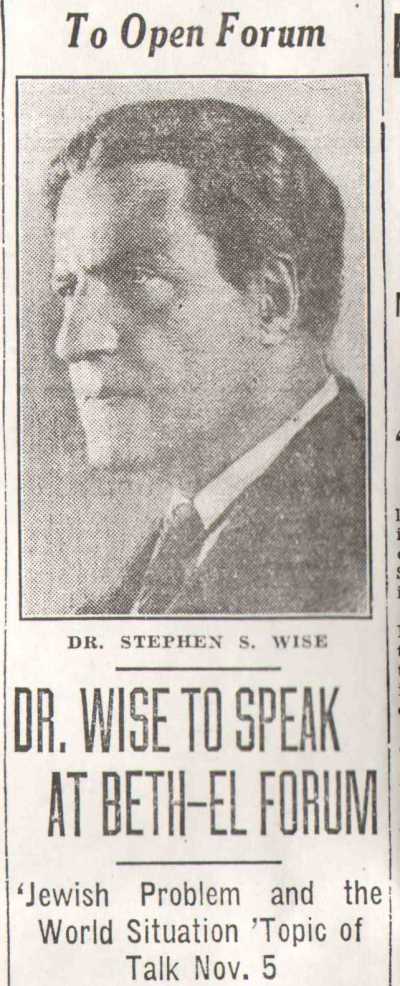
|
Camden
Courier-Post October 28, 1936
Congregation
Beth El |
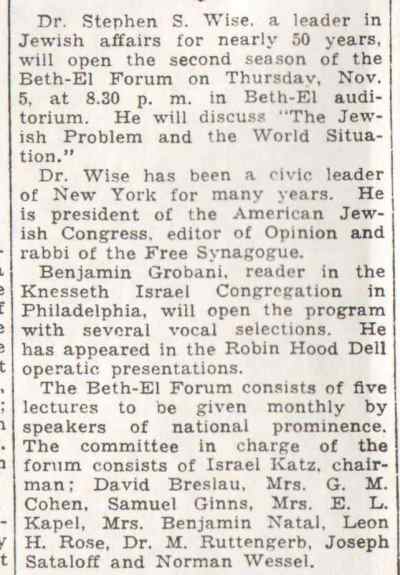
|
![]()
|
Camden Courier-Post * February 9, 1938 |
||||||
|
||||||
![]()
|
Camden Courier-Post * February 12, 1938 |
|
|
![]()
| Camden Courier-Post - February 17, 1938 |
| Mother-Daughter
Banquet Slated by Sisterhood Here
A mother-daughter dinner has been planned by the Beth El Sisterhood for Monday next. The affair will be held in the Beth El auditorium, Park boulevard and Belleview avenue, and has been arranged under the direction of Mrs. Meyer B. Chertkof, of Collingswood, and Mrs. Max Sherman, of this city. The dinner is slated for seven o'clock. Mrs. Philip Lipis, program chairman for the year, will act as toastmaster and Mrs. Harry Lutz, president, will greet the members and their guests. The program will include solo and ensemble song and dance numbers. Dolly Aughenbaugh will sing and dance strut style. Tresa Casey will give a Russian dance, Mary Heimerl, acrobatic and Anna Mae Etherington, tap. Members of the sisterhood also will participate in the program. Mrs. Max Greenstein will be the pianist. A playlet will be presented entitled, "Blame It On the Movies." The cast comprises Salina Seigle, Dorothy Cutler, Sara Cutler and Miriam Cantor. Miss Nettie Reiter will sing accompanied by her mother, Mrs. Otto Reiter.
|
![]()
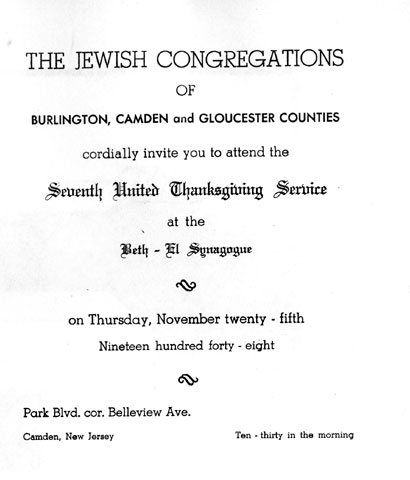
|
Thanksgiving
Services
November 25, 1948 |
|||||||||
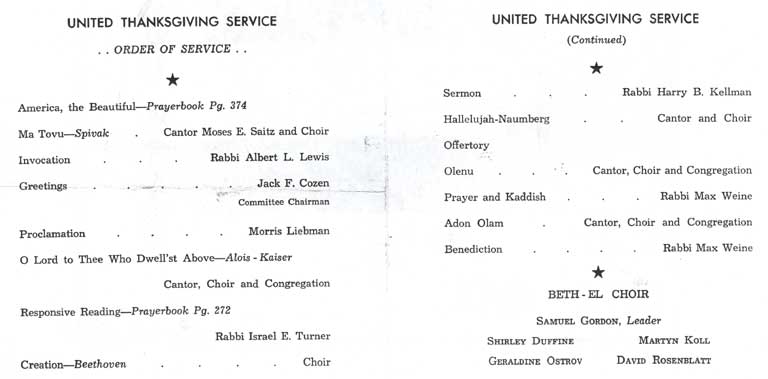
|
||||||||||
USHERS-Boy
Scouts
of
America,
Troop
18
, |
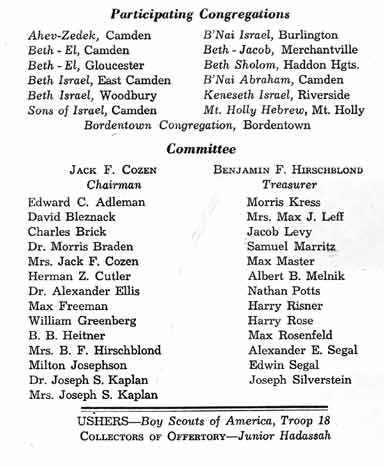
|
|||||||||
![]()
| The Beth El News Volume XX - Camden, N.J., Cheshvan 14, 5718 November 8, 1957 |
| Page 1 & Page 8 |
| Page 2 & Page 7 |
| Page 3 & Page 6 |
| Page 4 & Page 5 |
![]()

|
|
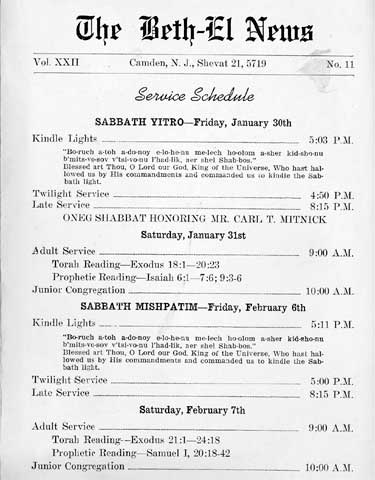
|
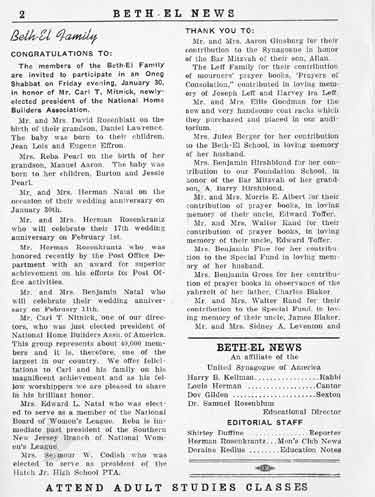
|
| Click on Image to Enlarge | |
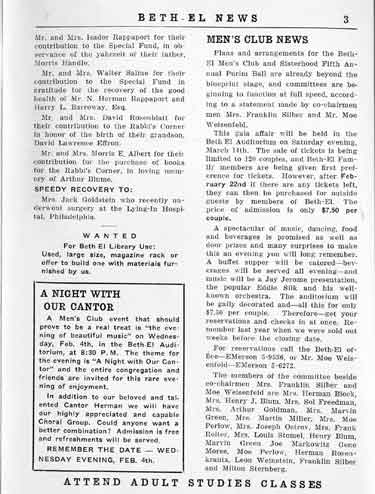
|
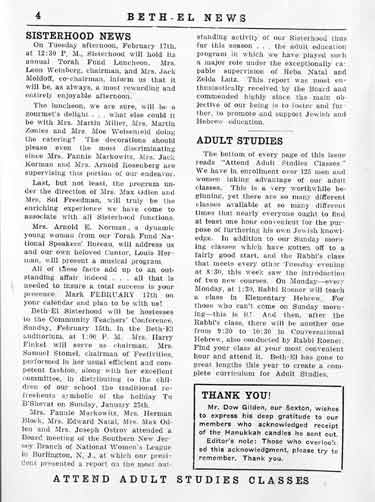
|
| Click on Image to Enlarge | |
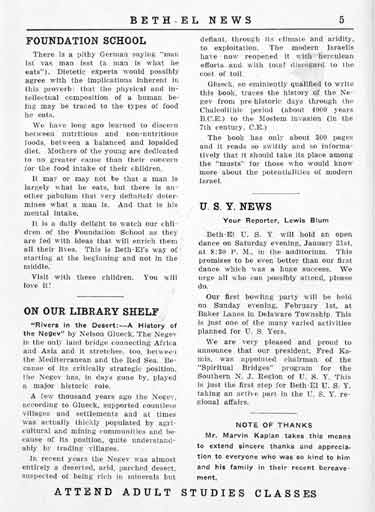
|
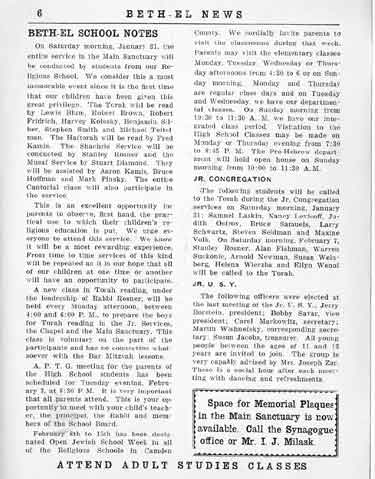
|
| Click on Image to Enlarge | |
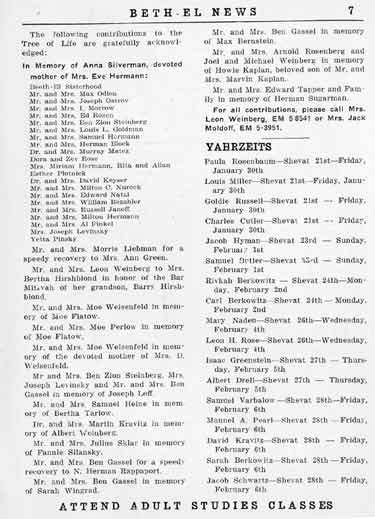
|
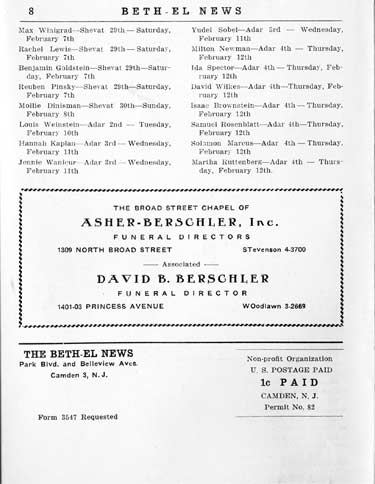
|
| Click on Image to Enlarge | |
![]()
| Installation
of Board of Directors - June 11, 1958 Beth El Auditorium |
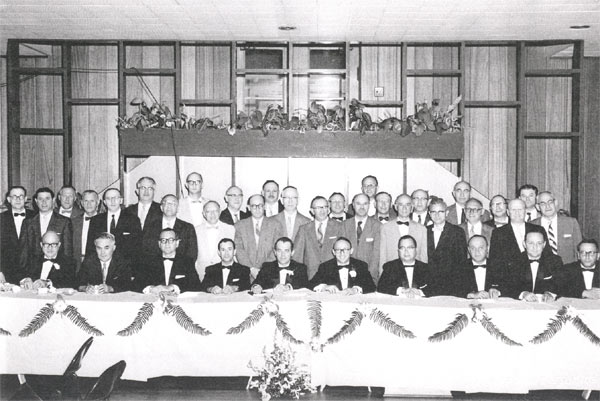
|
| Click on Image to
Enlarge
- Click
Here to Supersize Standing, 5th from left: Ellis Goodman |
![]()
| Beth El Choral Group - June 11, 1958, in Beth El Auditorium |
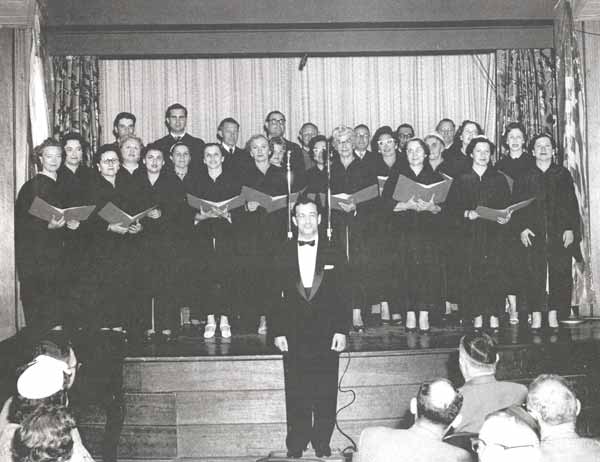
|
| Click on Image to Enlarge - Click Here to Supersize |
|
June 11, 1958 - Beth El Choral
Group |
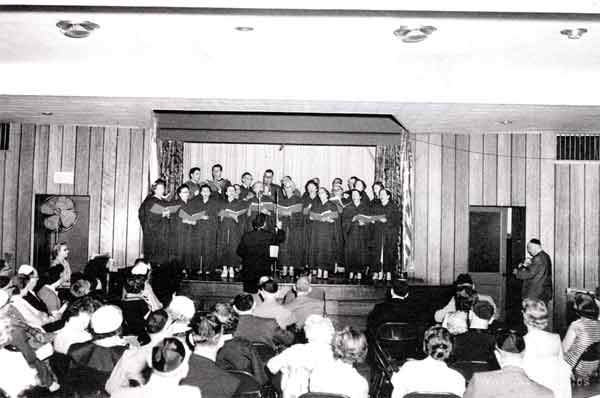
|
| Click on Image to Enlarge |
|
Late 1950s - Beth El Choral
Group |
| Click on Image to Enlarge |
![]()
| Bar
Mitzvah Jay Rosenkranz & Cantor Louis Herman in front of Beth El - October, 1958 |
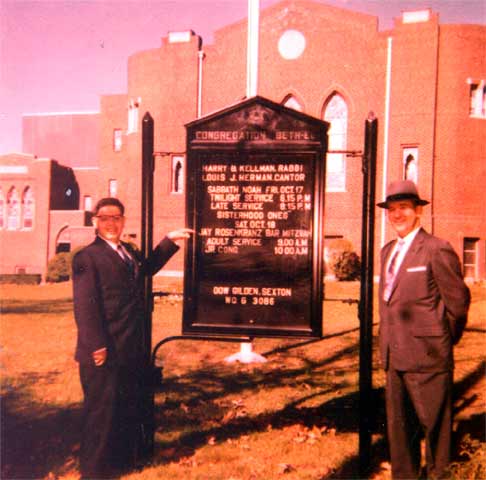
|
| Click on Image to Enlarge |
![]()

|
Thanksgiving
Services
November 27, 1958
|

|
|

|
|
![]()
| The Beth El News Volume XX - Camden, N.J., First Adar 5, 5719 February 13, 1959 |
| Page 1 & Page 8 |
| Page 2 & Page 7 |
| Page 3 & Page 6 |
| Page 4 & Page 5 |
![]()
| Beth El Chorus - circa 1960, in the old chapel |
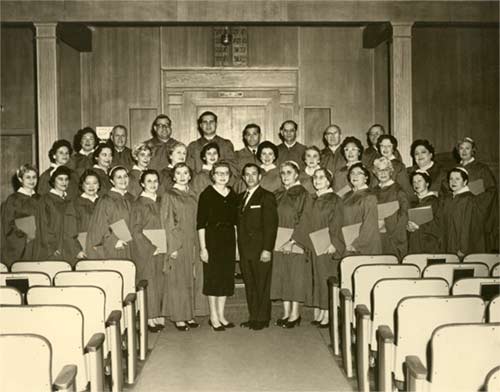
|
|
Front
row, sixth from left: Dora Rose, unknown, Rose Solomon,
Cantor Louis Herman, Fannie Markowitz, unknown, unknown, Mrs. Murray
(Sadie) Russell |
| Click on Image to Enlarge |
![]()
|
February 28, 1960 |
||||||||||||||||||||||||||||||||||||||||||||||||||||||||||||||||||||||||||||||||||||||||||||||||||||||||||||||||||||||||||||||||||||||||||||||||||||||||||||||||||||||||||||
|
THE CONGREGATIONS OF SOUTH JERSEY present THE CANTORS ASSEMBLY of AMERICA PHILADELPHIA REGIONAL BRANCH in its SECOND ANNUAL CONCERT OF JEWISH MUSIC for the benefit of THE CANTORS INSTITUTE OF THE JEWISH THEOLOGICAL SEMINARY "-to train young men of fine character for the sacred calling of the Cantorate." CONGREGATION BETH-EL Camden, New Jersey SUNDAY EVENING, FEBRUARY 28, 1960, AT 8:00 O'CLOCK CHORAL ENSEMBLE OF THE CANTORS ASSEMBLY
PARTICIPATING ARTISTS Mr. David J. Weiss Mr. Jacob Perlberg Additional Members of the Cantors Assembly, Philadelphia Region
OFFICERS OF THE CANTORS
ASSEMBLY
Program
Piano Courtesy, Wurlitzer Co., Phila. PATRONS Congregation Beth-El, Camden, N. J. Congregation Beth Sholom, Haddon Heights, N. J. Mr. and Mrs. Morris E. Albert SPONSORS
CONCERT COMMITTEE
GRATEFUL ACKNOWLEDGMENTS: -to the Beth-El Sisterhood for Concert Assistance
-to the Beth-El Men's Club for
Ushering and Assistance |
||||||||||||||||||||||||||||||||||||||||||||||||||||||||||||||||||||||||||||||||||||||||||||||||||||||||||||||||||||||||||||||||||||||||||||||||||||||||||||||||||||||||||||
![]()
|
June 11, 1961 Beth El School
Choir |
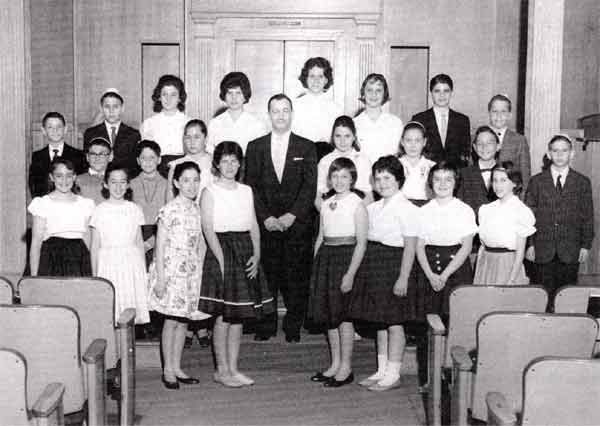
|
| Click on Image to Enlarge |
|
1961- Camden Mayor Alfred Pierce presenting a check to Cantor Louis J. Herman from the citizens of Camden in honor of their selection to participate in the International Choir Festival in Israel as Rabbi Kellman looks on. |
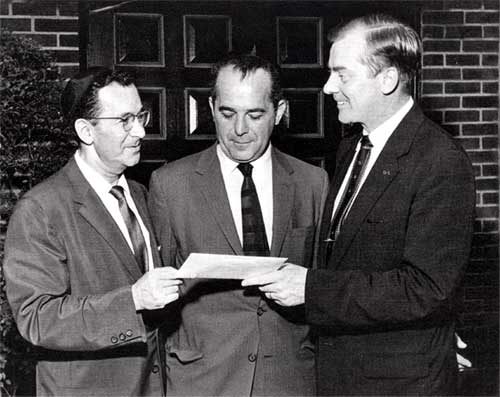
|
|
1961 - Beth El Choral Group
visits Rome |
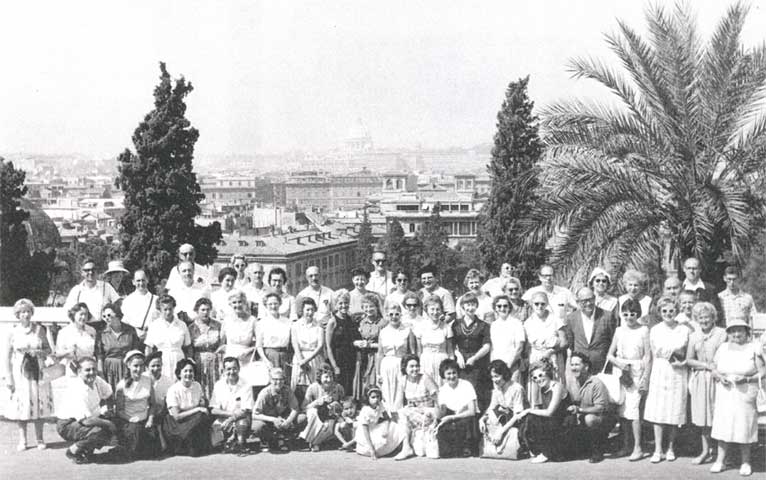
|
| Click on Image to Supersize |
![]()
![]()
| Beth El
Kindergarten - 1963 Click on Image to Enlarge - Click Here to Supersize |

|
|
Front
Row: |
| Beth
El Academy Nursery School - May 1963 Click on Image to Enlarge |
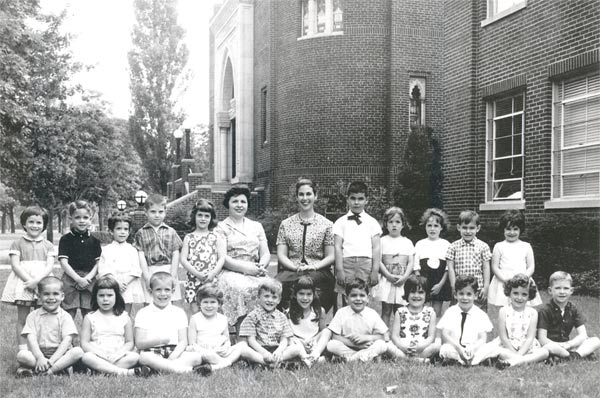
|
|
Front : Unknown, Unknown, Jeffrey Schwartz, Unknown, Michael Reiter, Unknown, Unknown, Unknown, David Herman, Unknown, Unknown. Rear: Unknown, Unknown, Unknown, Unknown, Briana Singer, Mrs. Freida Gilden, Ms. Leslie Kurland, Joel Yaffa, Unknown, Unknown, Unknown, Shawn Beller. |
| Beth El
Kindergarten - 1964 Click on Image to Enlarge |
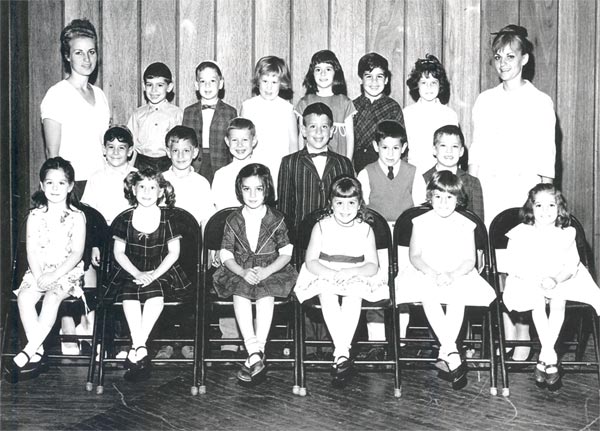
|
|
Front Row: Harriet Brown OR Melanie Levinson, Erica Leiberman, Sharon Beller, Amy Korbin, Unknown, Devorah Scheiner. Middle Row: David Herman, Michael Rester, Stanton Meltzer, Jeffrey Schwartz, Jeff Beyer, David Spector. Top Row: Mrs. Klein: Keith Meretz OR Jeff Melrose, Unknown, Unknown, Briana Singer, Unknown, Unknown, Mrs. Cohen |
|
21 kids [in 1963], look at the drop- the next year 18 kids. Any wonder why they moved to Cherry Hill? David Herman, October 2007 |
|
Ms. Klein was Israeli... David Herman, October 2008 |
![]()
| Confirmation
Class &Hebrew High School Graduation May 17, 1964 |
|||||||||||||||||||||||||||||||||||||||||||||||||||||||||||||||||||||||||||||||||||||||||||||||||||||||||||||||||||||||||||||||||||||||||||||||||||||||||||||||||||||||||||||||||||||||||||||||||||||||||||||||||||||||||||||||||||||||||||||||||
|
|||||||||||||||||||||||||||||||||||||||||||||||||||||||||||||||||||||||||||||||||||||||||||||||||||||||||||||||||||||||||||||||||||||||||||||||||||||||||||||||||||||||||||||||||||||||||||||||||||||||||||||||||||||||||||||||||||||||||||||||||
![]()
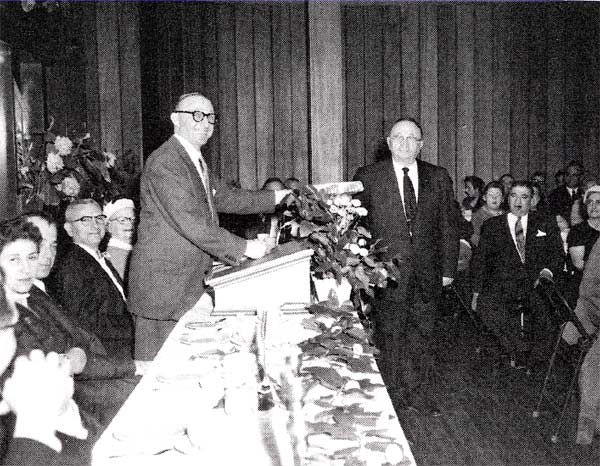
|
Early
1960s
Beth El President At the head table, from left: Seated, at right, |
![]()
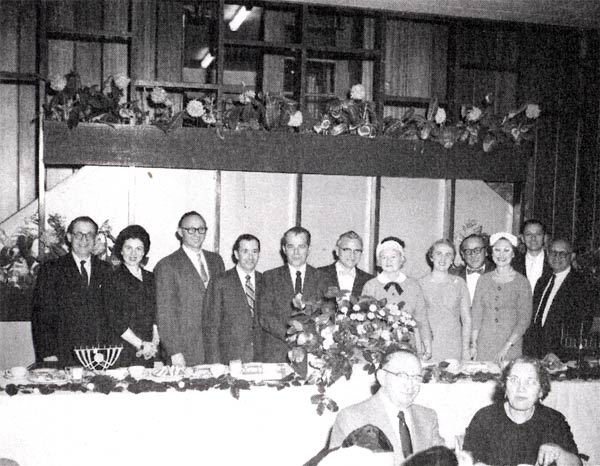
|
Hannukah
Breakfast 1960s Standing, from left: Click on Image to Enlarge |
![]()
| The Beth El News Volume XX - Camden, N.J., Kislev 23, 5726 December 17, 1965 |
| Page 1 & Page 8 |
| Page 2 & Page 3 |
| Page 4 & Page 5 |
| Page 6 & Page 7 |
![]()
![]()
| Beth El
Second Grade - 1966 Click on Image to Enlarge- Click Here to Supersize |
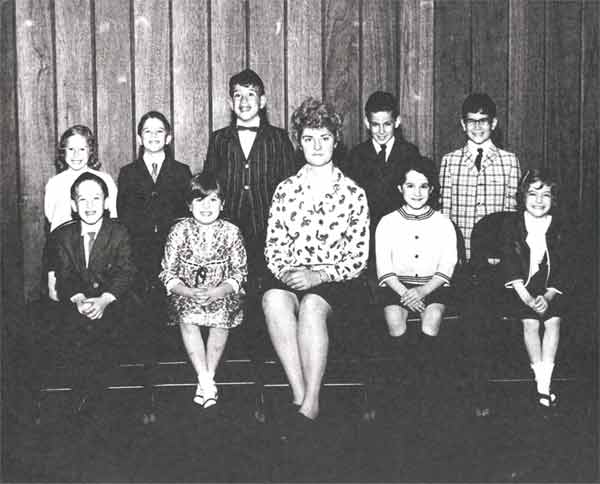
|
|
Front Row: Merrill Meadows, Amy Korbin, Miss Regina Lutek, Harriet Brown, Devorah Sheiner. Back Row: Erica Leiberman, David Spector, Jeff Schwartz, Jeff Beyer, David Herman |
|
Notice how the class keeps shrinking, because we were still in Parkside. David Herman, October 2008 |
![]()
![]()
| Dedication of Congregation Beth El May 26, 1968 |

|

|

|

|
| Beth El
Third Grade - June 4, 1968 Click on Image to Enlarge |
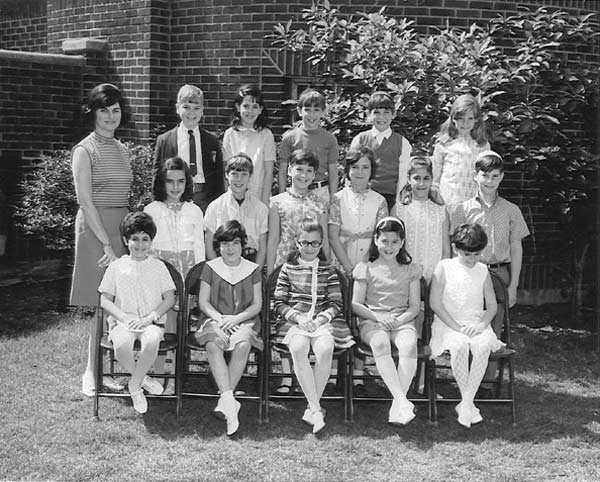
|
|
Bottom
Row: Lori Schuldiner, Carol Finkel,
Nancy Melrose, Kathy Stevens, Eileen Dubin |
![]()
|
Rabbi Howard Kahn,
Rabbi Harry Kellman, Cantor Louis Herman Beth El, Cherry Hill, 1980s |
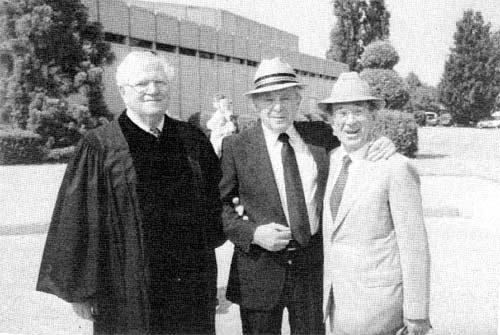
|
![]()